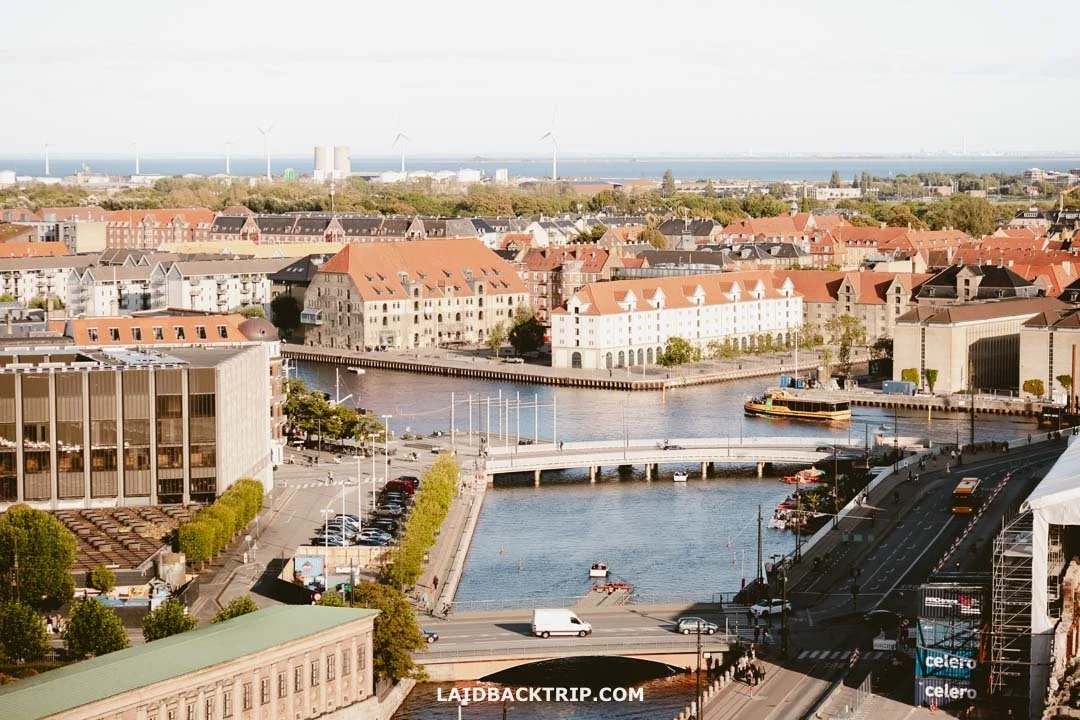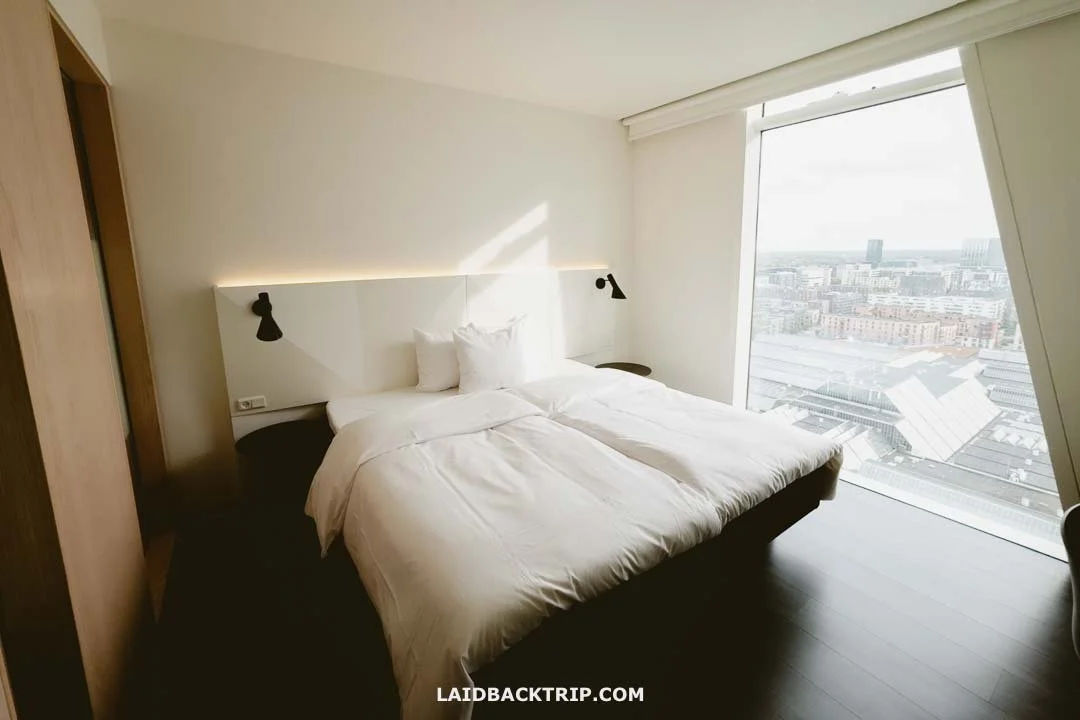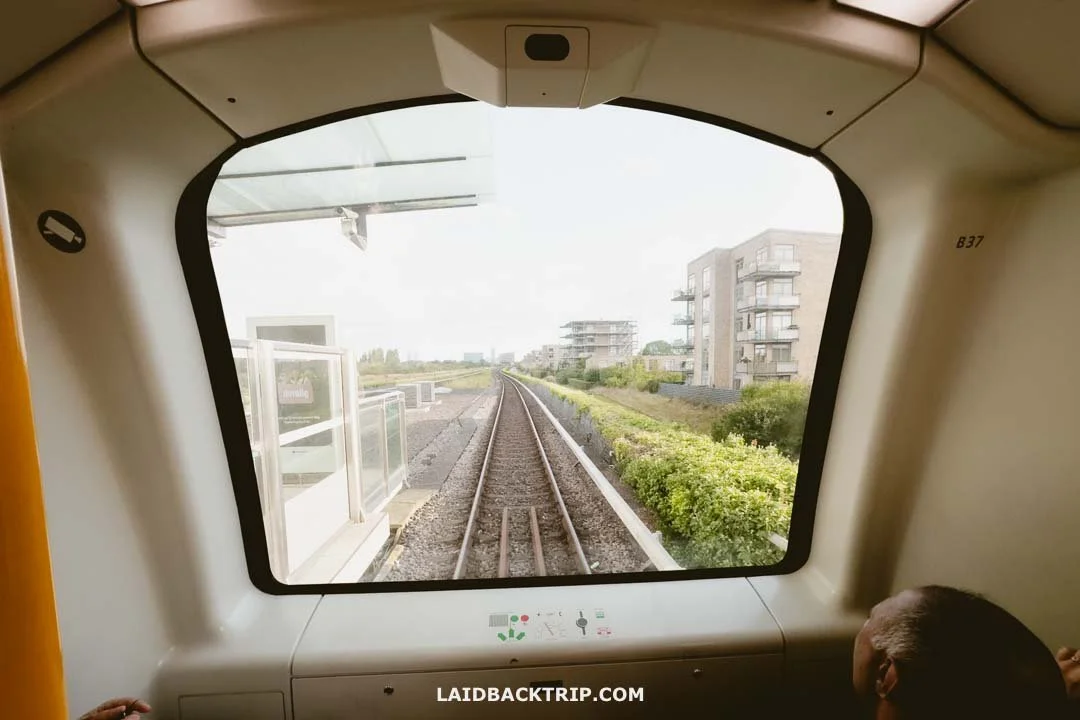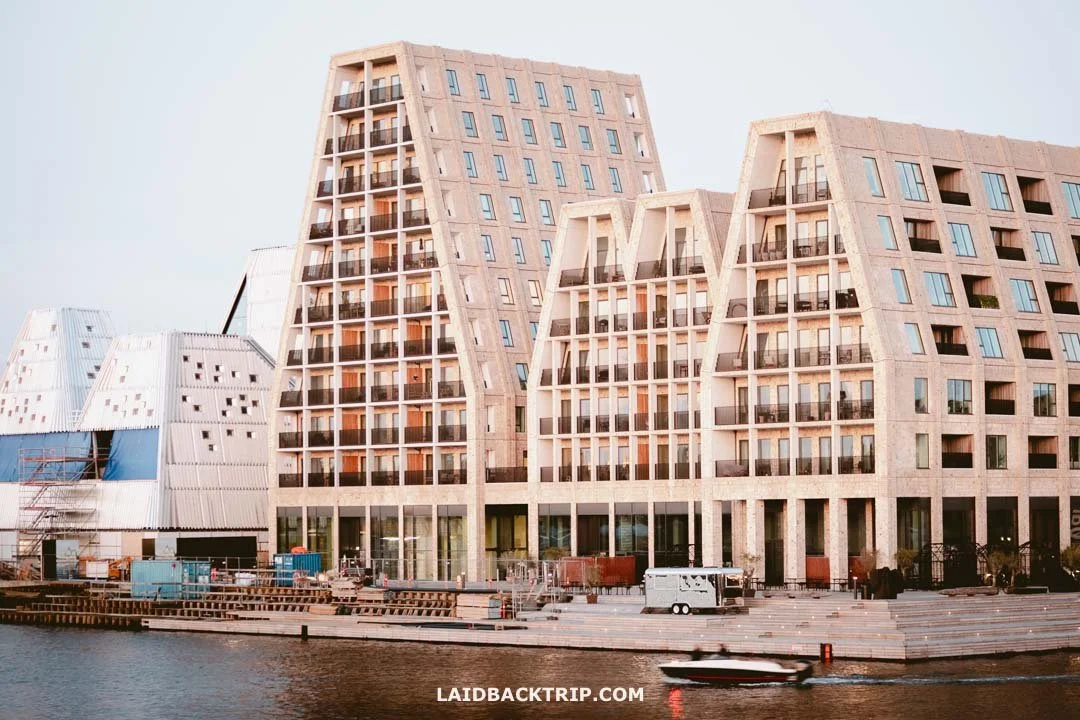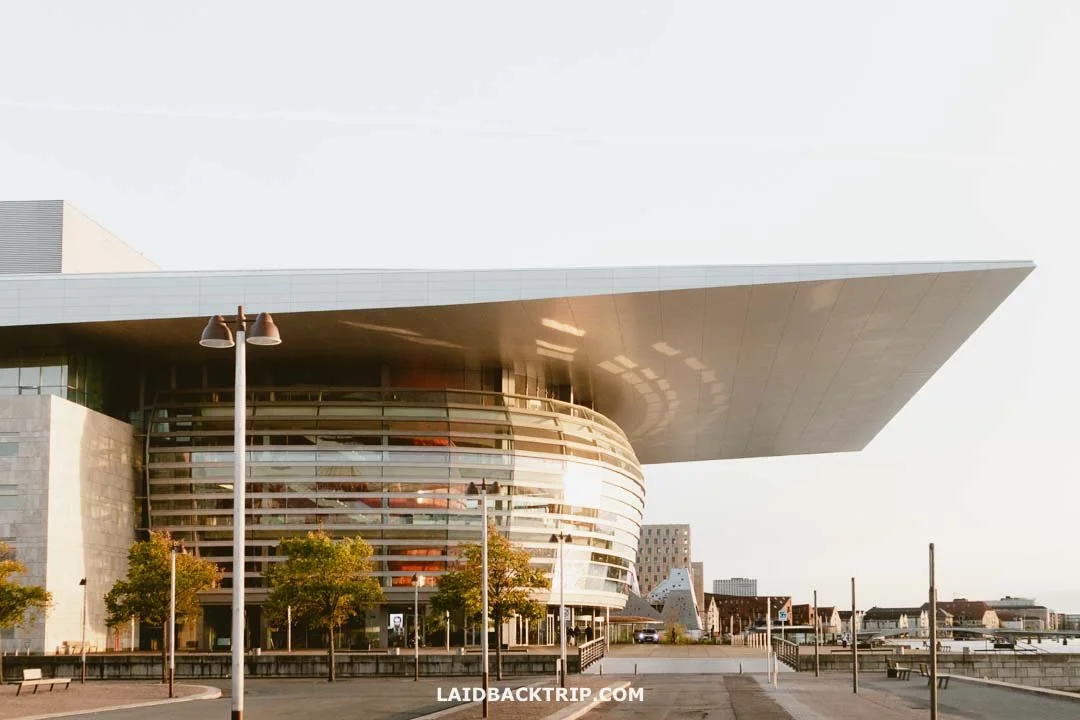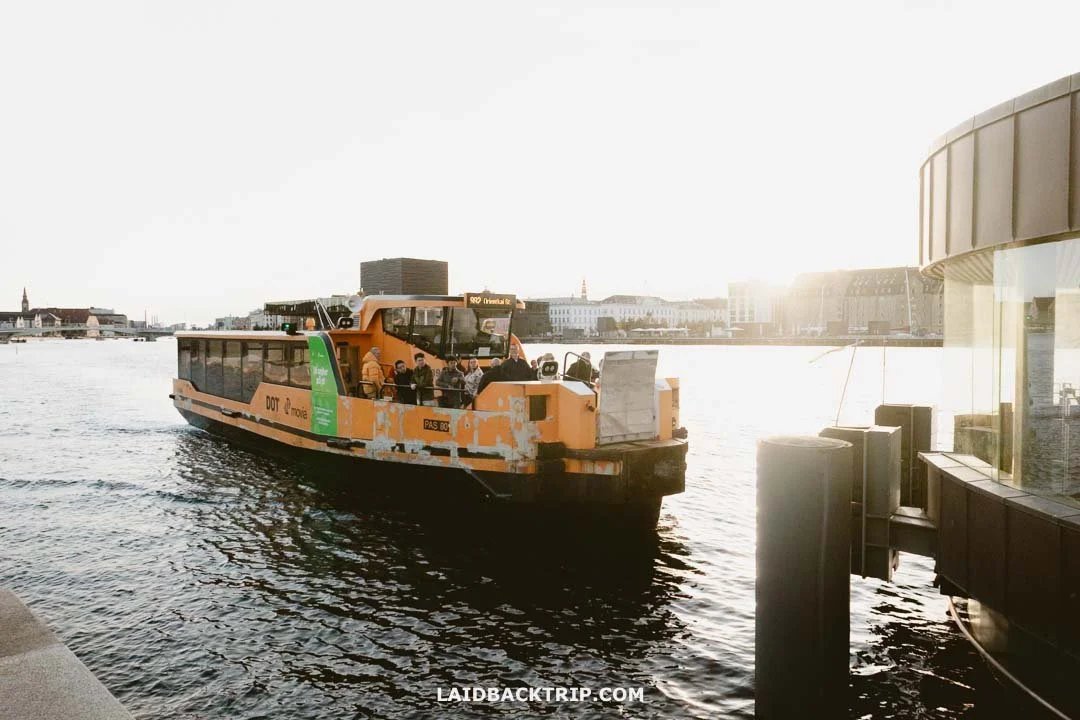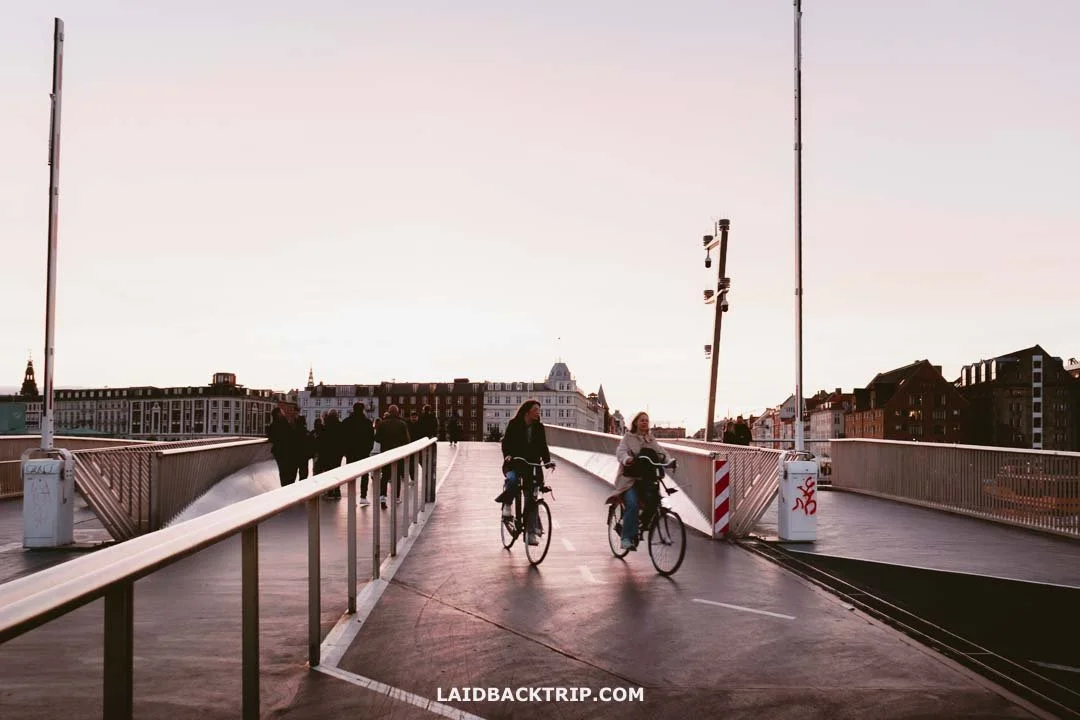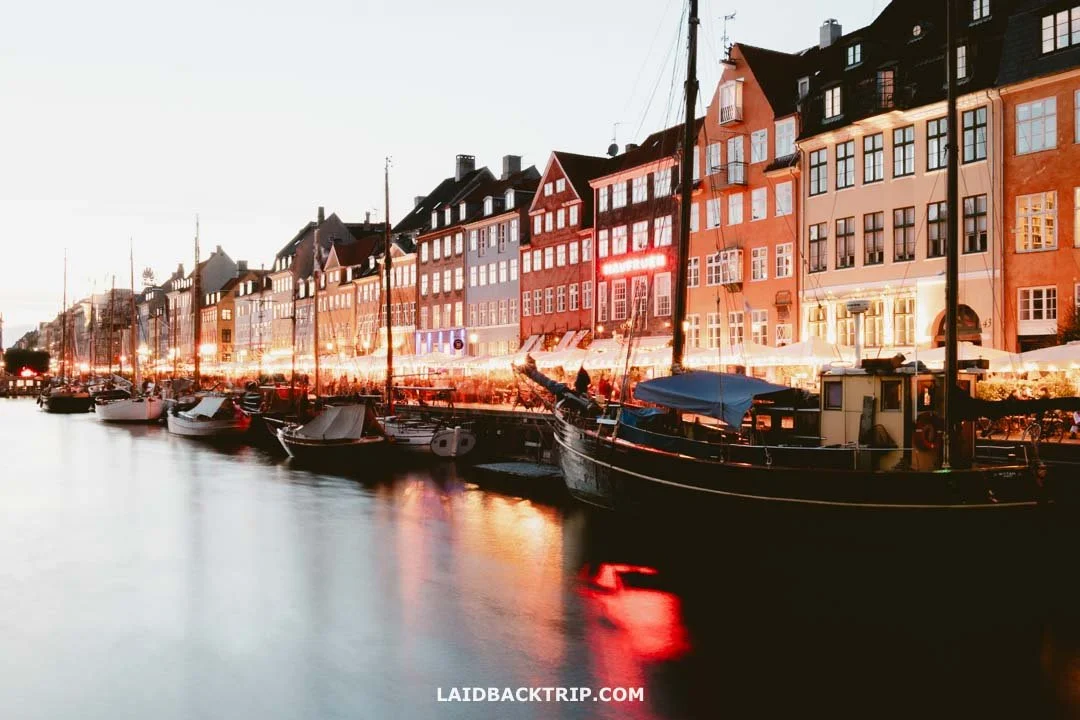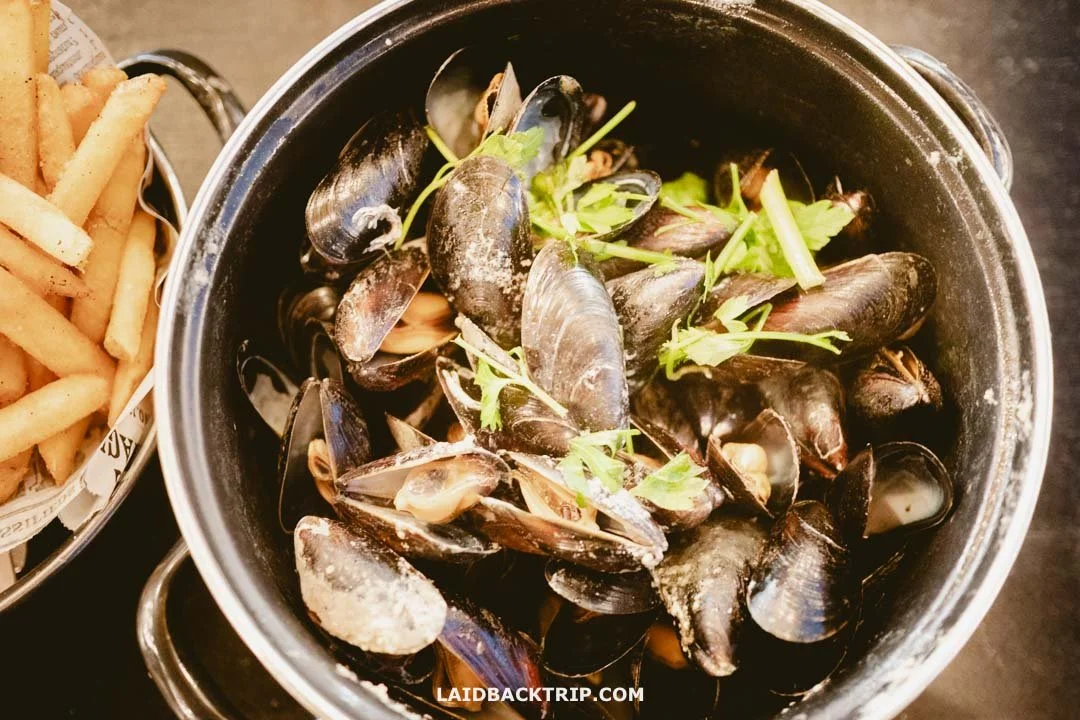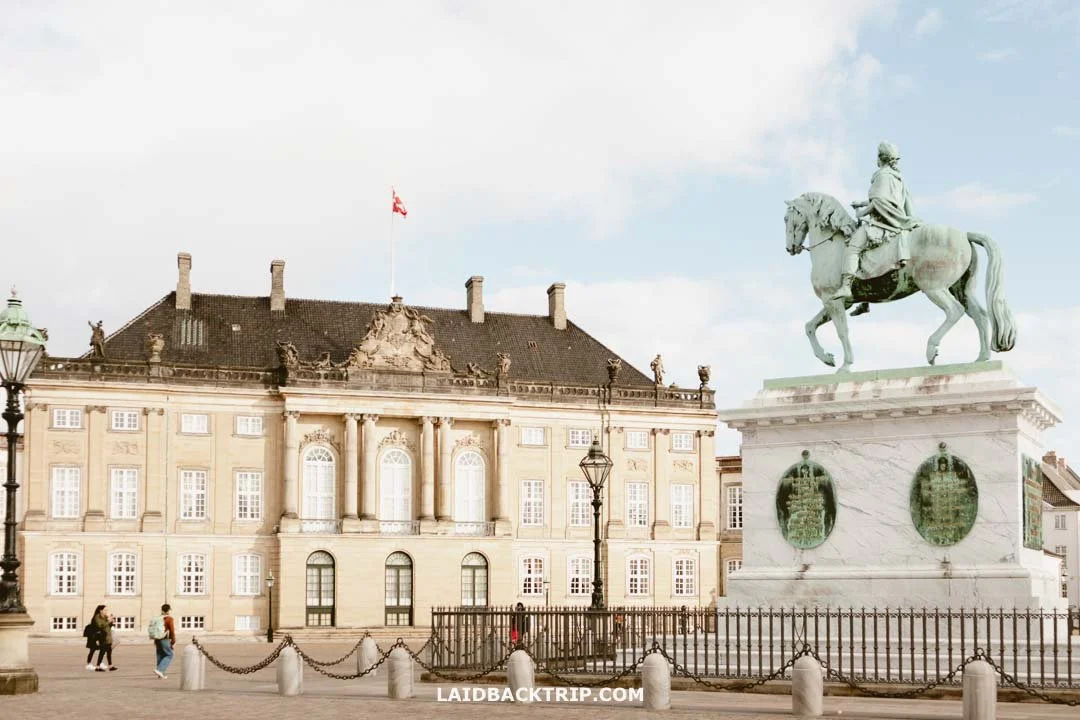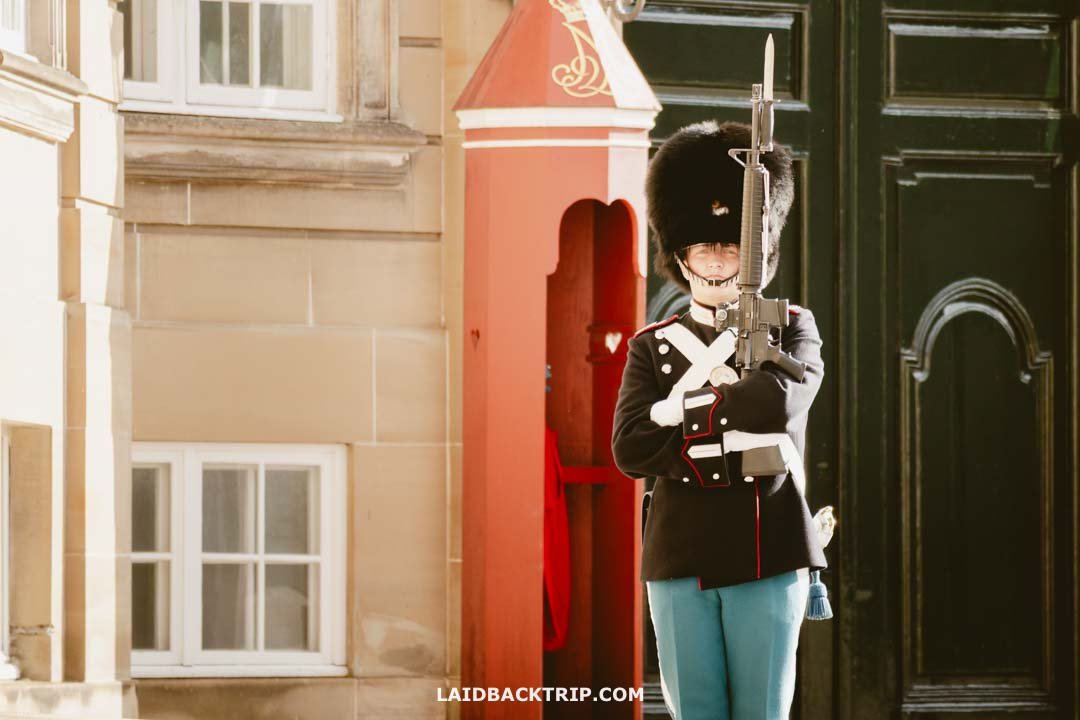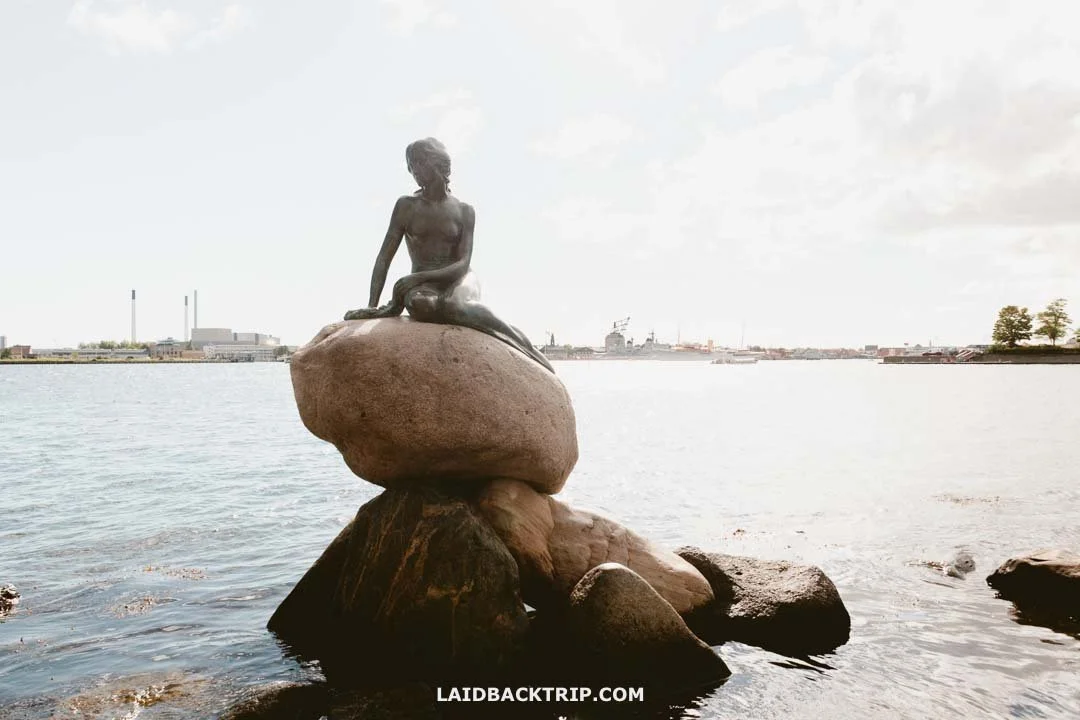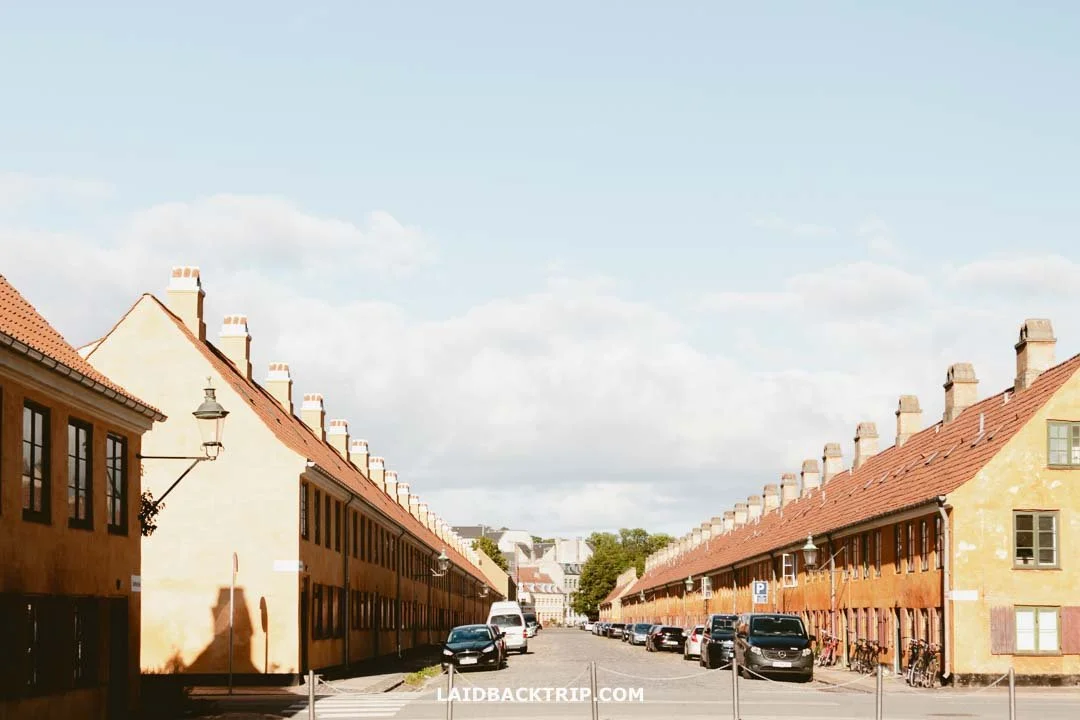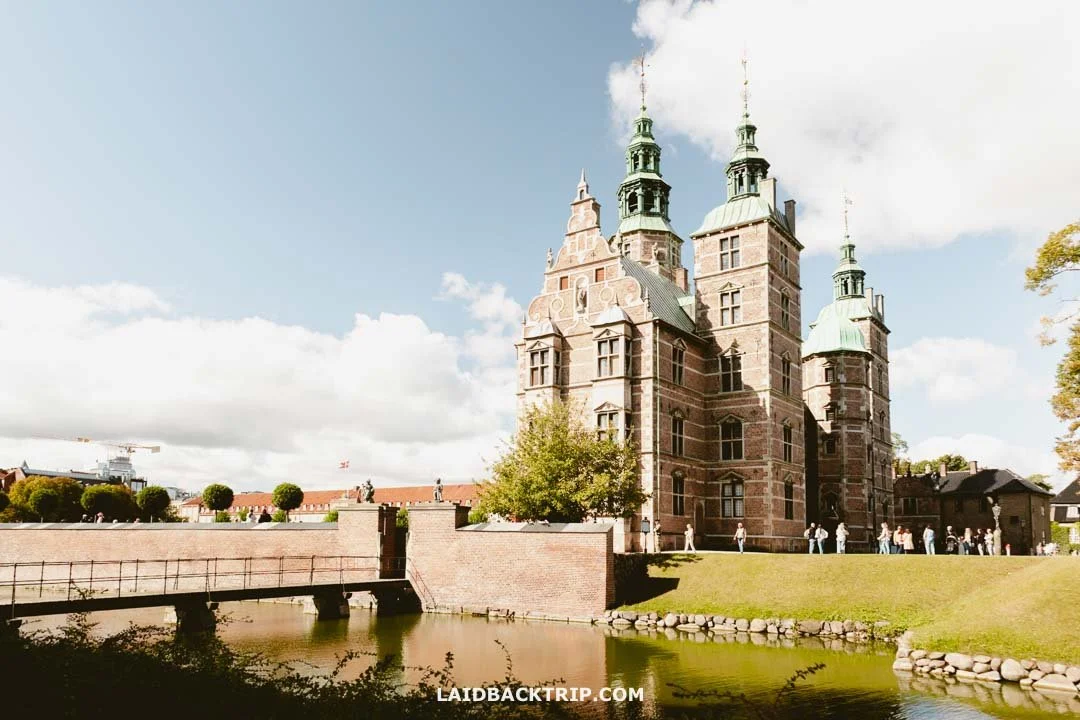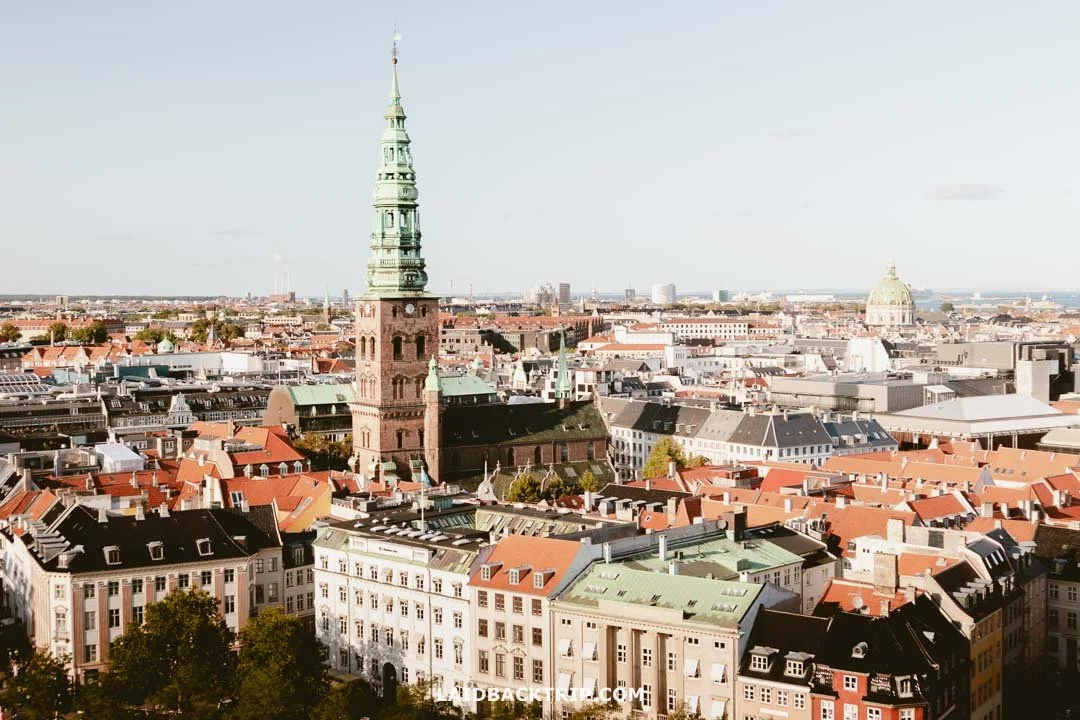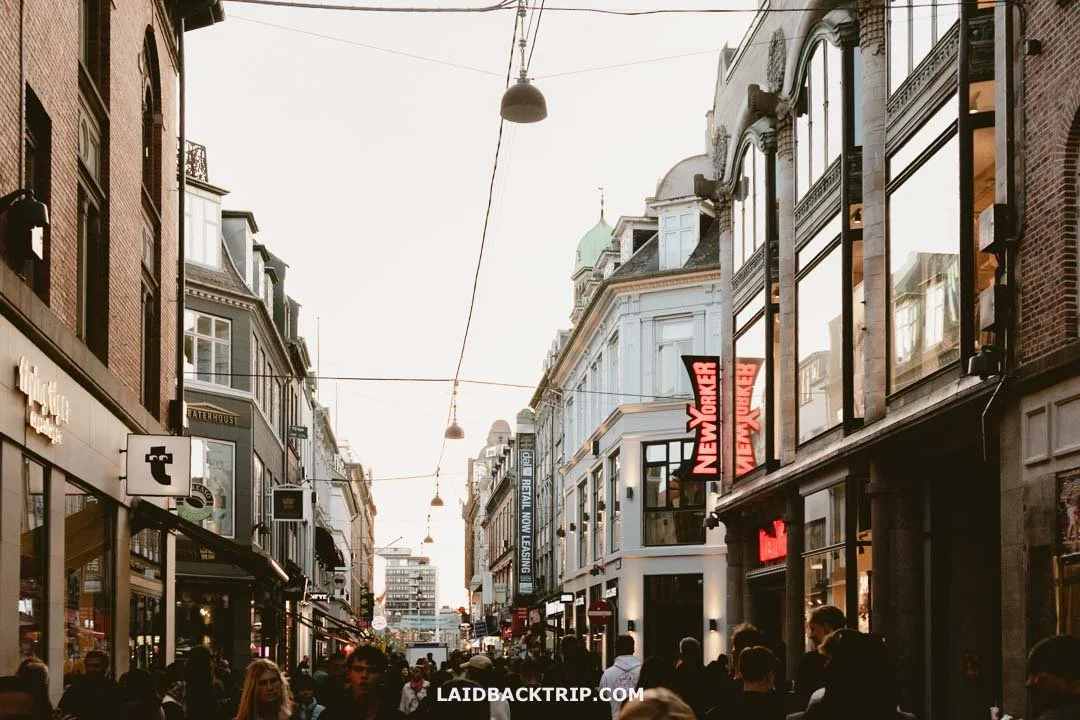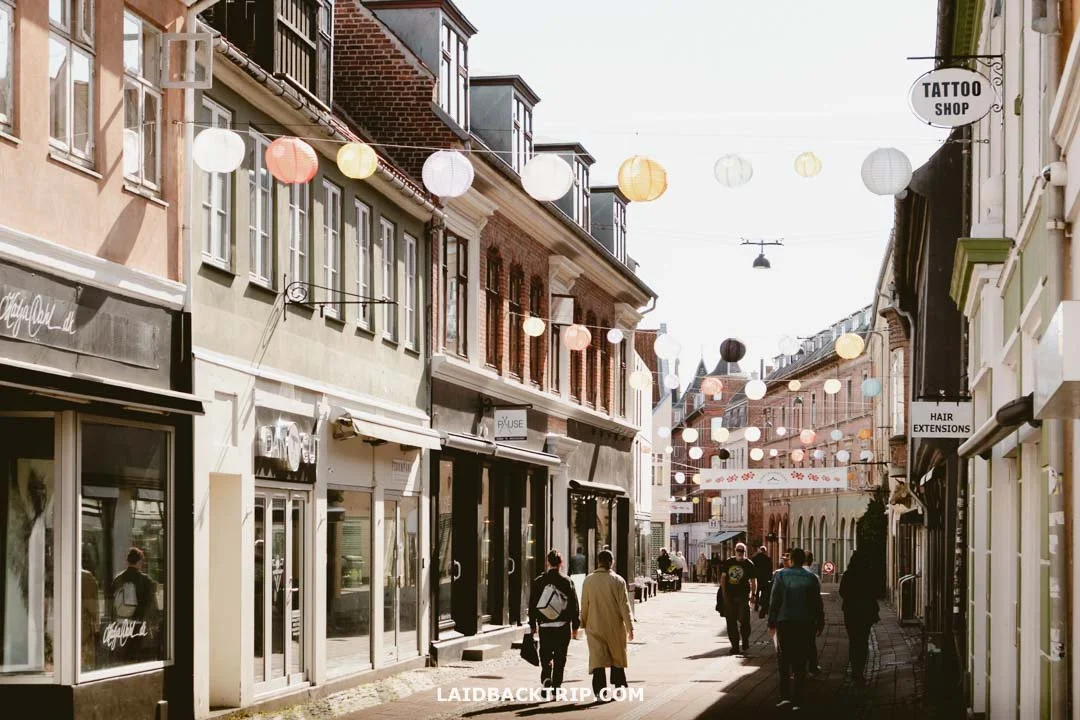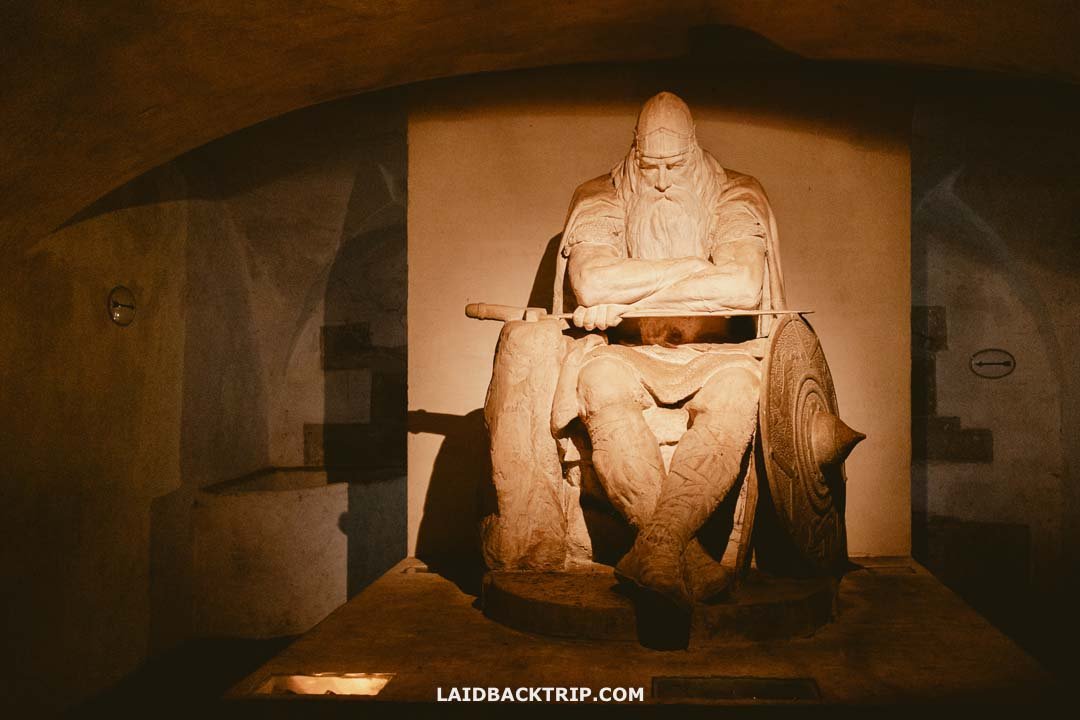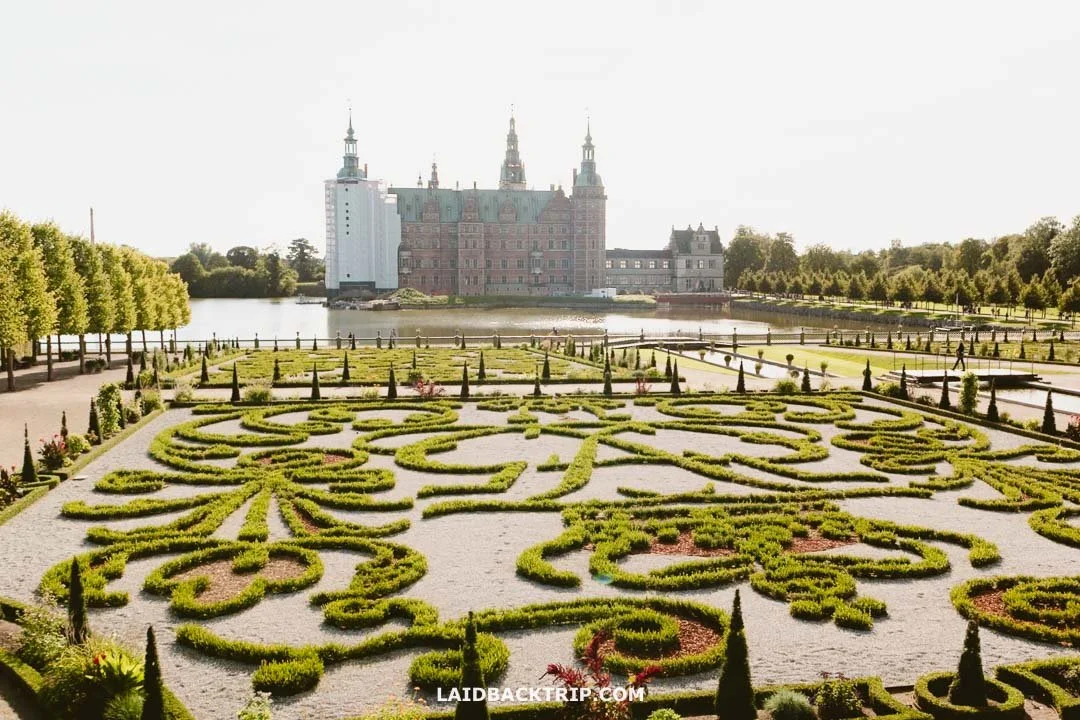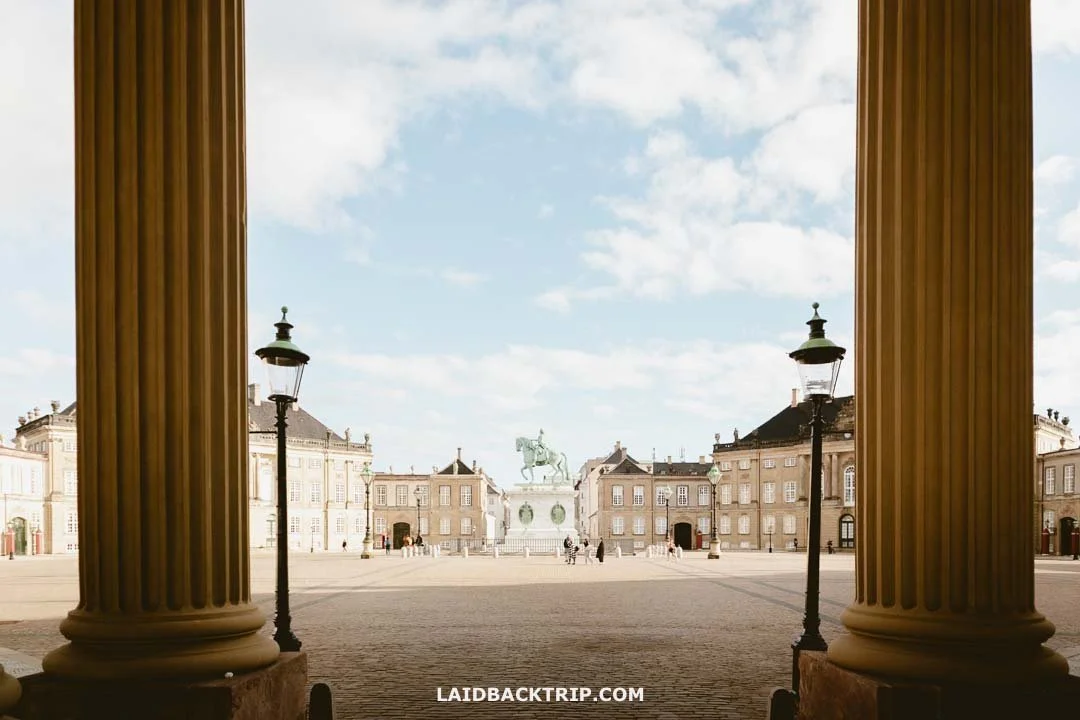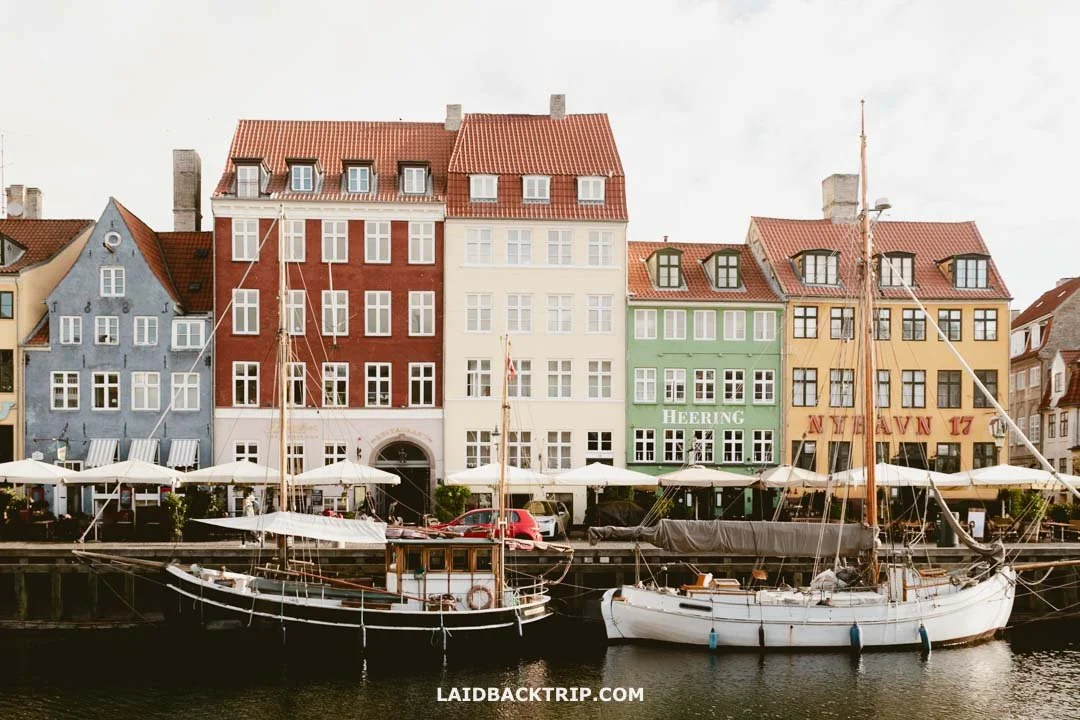How We Spent 3 Amazing Days in Copenhagen (+ Itinerary)
Copenhagen very quickly became one of our favorite cities we've ever visited.
Here's a complete guide to how we visited Copenhagen on our Denmark trip.
Copenhagen is the capital city of Denmark and easily one of the must-sees on the island of Zealand. For most international visitors, it is actually the first place they visit in this Scandinavian country since it has a large international airport. Our story was a bit different, though. We visited Copenhagen last, as it was part of a long road trip throughout the entire country.
Since we started our Denmark road trip in Jutland, it took us almost two weeks to get to Copenhagen, which is located on the other side of the country. The journey was incredible, filled with unspoiled beaches, stunning cliffs, Viking sites, and much more. And, obviously, Copenhagen was meant to be the highlight of the trip.
While we had already explored a few larger cities, like Aarhus and Odense, we were especially excited to finally see Copenhagen because it offers the only true big-city experience in Denmark. And for us, it was also our very first taste of a big city in Scandinavia.
We had three days in Denmark's biggest city. We were not sure if that would be enough, as it looked like there were so many things to do in Copenhagen, but it was all the time we had. Since it was our first visit, we focused on the main attractions but still managed to fit in a few off-the-beaten-path spots. The result is this 12,500+ word guide on how we spent those days, hopefully packed with useful tips.
Even from above, Copenhagen looked stunning.
Where to Stay in Copenhagen
So, the first thing we needed to figure out was where we would base ourselves for the next three days. Our itinerary was fairly loose, and since we had no idea exactly when we would arrive, we started looking for accommodation pretty much at the last minute. In this case, that meant the evening before, which was obviously not ideal.
After a quick search, we discovered three things. The first was that Copenhagen has some really great hotels in the city center (no surprise there), and the second was that accommodation is really pricey (we saw that one coming, too). The third "discovery" was that since we were arriving for a weekend and without any reservation, everything that looked decent had already been booked, and the remaining hotels, aware of this, had raised their prices even more. It was unfortunate, but it was the consequence of having a flexible itinerary. Besides the classic requirements, like a clean room in a good location, we also needed easy parking since we were arriving by car.
Bella Sky Hotel is definitely one of the coolest buildings we've ever stayed in.
After some searching and a quick debate, we chose the AC Hotel by Marriott Bella Sky, one of the best hotels in Copenhagen. It was more expensive than we wanted, but it was very comfortable and had everything we needed. Plus, it is easily one of the most remarkable buildings in Copenhagen in terms of architecture.
The hotel is about six kilometers from Nyhavn, so walking was out of the question, but it was less than five minutes from a metro station, so we didn't mind being a bit outside the center. If this had been a longer trip, we might have done the walk as a kind of morning exercise, but with only a few days, the metro made more sense.
We got a room on an upper floor so we could also enjoy some really nice views of Copenhagen's outskirts.
The hotel offered paid parking right next to the building, but we chose to leave the car in the Royal Golf parking lot across the street, which was much cheaper.
We also liked some of the more central hotels within Indre By district, and if it weren't for the reasons mentioned, we probably would have picked one of them. Motel One Copenhagen was at the top of our list. It's modern, comfortable, and ideally located between Tivoli Gardens and Christiansborg.
For budget travelers, Cabinn City is a solid choice. The rooms are small, often with bunk beds, but their economy private rooms are perfect if you want to spend as little as possible on accommodation. For solo travelers who prefer dormitories, Generator is one of the best hostels in the city.
Something in between is Next House Copenhagen, which has great reviews and offers both dorms and private rooms. CityHub Copenhagen is also popular, especially if you like the capsule hotel concept.
If you want maximum comfort, Hotel Sanders is one of the most luxurious stays in Copenhagen. It is expensive, like really expensive, but it offers one of the few true five-star experiences in the city. Whether it is worth the price is up to you.
Things to See and Do in Copenhagen in 3 Days
Copenhagen, as the biggest city in Denmark and its capital, naturally has a lot to see and do. It offers the usual mix of historical landmarks and various museums, all set against a stunning seaside backdrop filled with beautiful canals, passing boats, and modern architecture. If I had pictured the city in my mind before the trip, the reality came very close to that image.
Apart from the typical sights, Copenhagen has cool spots like CopenHill, a waste-to-energy plant with a year-round artificial ski slope.
We had three days in Copenhagen, which sounded like a good amount of time for this city. It also meant we needed to come up with a plan for how to spend them. We decided the itinerary should have some structure and a clear goal, so we dedicated each day to different things.
On the first day (arrival day), we took things slowly and just got a better sense of the city. It was a day meant to give us a feel for the place without requiring museum visits or anything similar. This was definitely one of Copenhagen's strengths. We did not have to plan much and simply walked around one of its most famous neighborhoods, which was an experience in itself. You could easily swap the walk for a canal cruise, which is also a great way to see the city.
Canal cruises are super popular in Copenhagen.
On the second day, we focused on the main attractions, aka the usual things every tourist should do on their first trip to Copenhagen. While the other two days were a bit more flexible, the second day was the most important part of our itinerary for an average visitor, so we put real effort into making it as practical as possible. It simply follows our route for exploring Copenhagen's must-sees, but we do not think it is the only way to do it, so even this day can be adjusted to fit your pace.
Marble Church is definitely one of Copenhagen's most stunning landmarks.
On the third day, we focused on Copenhagen's surroundings, which offer some really great trips from the capital. There is plenty to see and do outside the city, so this third day can easily stretch into a fourth or even fifth day if you have the time. But if you are in Copenhagen for only three days, like we were, we think the itinerary below covers everything a first-time visitor should experience in the city.
Is the Copenhagen Card Worth It?
Since the next three days are packed with Copenhagen's top attractions, it is pretty clear you will spend a fair amount on admissions. We already knew that and were prepared for the higher prices, especially after spending the last week visiting various museums and attractions across Denmark, most of which were quite pricey. And not just the obvious ones like Lego House, but also the traditional ones like Tirpitz or Hanstholm.
Now it was time to see a few paid attractions in Copenhagen, and that is when we realized our mistake. We have already said that this trip was a pretty spontaneous one, and once we got to Copenhagen, we realized the downside of not planning ahead. That is when we learned that Copenhagen has its own city pass, and the "mistake" was that it also covers several attractions outside the city. We had already been to a few of them earlier in the trip, so by the time we found out, getting the pass did not make much sense anymore.
The 72-hour Copenhagen Card version is clearly the best value, but even the shorter passes can help you save. Just match the list of included attractions with what you want to see, do the math, and decide if the city pass is worth it for you.
Obviously, Copenhagen’s most popular attractions like Rosenborg, Christiansborg, Tivoli Gardens, the Round Tower, and tons of others are included, as well as Kronborg, Roskilde Cathedral, Frederiksborg, which are outside the city. Another great thing about this pass is that it also includes public transport!
Copenhagen Metro is fully automatic and driverless!
Day 1 in Copenhagen: Nyhavn, Christiania, Waterfront Walks, Modern Architecture, and Food
We arrived in Copenhagen in the afternoon, and after a quick check-in, settling into our room, and a very short rest, we decided there was no point in staying in the room any longer and headed for the city center. Since our days on the road usually started before sunrise and ended after sunset, and this one was no exception, we chose to take things a bit more slowly that evening. We walked to the metro station while talking about where we should get off and what we should see first.
It was under a 10-minute metro ride from Bella Center to Copenhagen's city center.
Since we did not find any of Copenhagen's museums or attractions open in the evening, at least not on the Friday evening we visited, we decided to take it easy and just wander around the city center, see Nyhavn, and take a long walk along the waterfront. Honestly, we were not in the mood to spend the rest of the day indoors anyway. And don't worry, even with this casual plan we saw quite a lot.
But if you arrive earlier than we did, or you are starting your day in Copenhagen with a full schedule ahead, we would recommend visiting the National Museum of Denmark, as it gives a great background on the country's history.
Walking Around Christianshavn
Anyway, we took the metro from Bella Center to Christianshavn, as our plan was to walk toward the Copenhagen Opera House (Operaen) and explore this part of the city, which looked really cool on the map with its canals and islands connected by numerous bridges. I would say that while Christianshavn does have some interesting sights, such as the Church of Our Saviour and the free town of Christiania, those are not really the main reasons to visit.
Right from the start, we noticed how pleasant it was to walk around Christianshavn. It was not exactly quiet. There were tourists, locals, plenty of cyclists, and, of course, boats moving through the canals, with cruises packed to the last spot. But even with all that activity, it did not feel overwhelming and had an almost intimate atmosphere. We picked up on that right away, and it became even more noticeable the next day when we visited the other side of the Inner Harbor, where all the main attractions are located.
With views like that, Christianshavn was one of our favorite places for walks in all of Copenhagen.
And that was even when we stayed on the touristy side along the Christianshavn canal. But even fewer people were along the eastern edge of the neighborhood, which is lined by Christianshavns Vold, a well-preserved section of Copenhagen's old fortification ring that's now a park with walking trails. Besides walking, one of the best ways to explore Christianshavn is by taking a canal cruise to see the neighborhood from the water, or by climbing the spiral tower of the Church of Our Saviour for a view from above.
We got off the metro at Christianshavn station, located on Christianshavn Square. Interestingly, the square wasn't as picturesque as the rest of the neighborhood since a busy road, Torvegade, runs right through it, making things a bit hectic, so we quickly left it behind. Just a few steps from the station is the Christianshavn Canal, which was truly the highlight of our visit.
Of all the things to do in Christianshavn, this simple walk along the canal was definitely our favorite. The canal was lined with a mix of red-brick and other historic buildings (there were even some cute half-timbered houses) along with modern ones, while boats were docked on both sides. The cobblestone streets made the whole scene even more picturesque.
The Christianshavn Canal is definitely a must-see!
Visiting the Free Town of Christiania
One of the first stops we made in this neighborhood was Christiania, the famous free town located right in Copenhagen's center. We mostly stopped by because it was pretty much along the way, though we can't deny we were a bit curious about what the place would actually feel like, since so much has been said and written about Christiania.
Christiania is a free town, or more precisely, an autonomous district with self-declared rules, located right in the center of Copenhagen. It started back in the 1970s when a group of squatters, artists, and activists took over abandoned military barracks in this part of Christianshavn. Over time, the neighborhood became known not just for its alternative lifestyle but also for Pusher Street, which became synonymous with its open cannabis trade, tolerated for decades despite being illegal in Denmark. Today, it's a popular tourist spot visited by more and more people every year.
The Free Town of Christiania is definitely not a typical tourist attraction.
We'd read plenty of mixed stories about Christiania, and I'd say ours was about as ordinary as it gets. The area was really quiet and laid-back. It was a Friday afternoon, and besides a few other tourists, it felt almost empty, like there wasn't much life around. The neighborhood was a blend of neglected buildings, graffiti, street art, cafes, pubs, souvenir shops, and a few shady-looking spots, all with a definite hippie vibe.
Overall, it didn't feel all that interesting, at least for us, since we were pretty much just passing through and weren't there to drink, buy souvenirs, or take part in the activities Christiania is known for. While it's still very much a living community, I can't help but feel that tourism is slowly diluting its hippie spirit, which is really just the inevitable result of any place that becomes popular.
Christiania is known for street art.
Christiania also felt safe, which was definitely something we weren't sure about before visiting. We had read a lot of information about the neighborhood's safety and visiting in general, but the messages were often conflicting, ranging from "everything is totally fine" to "don't go, it's not safe," plus claims that locals don't like tourists. While we didn't spend much time there, we walked around and never felt unsafe at any point.
That said, there were some gang-related shootings in Christiania in 2024, and a few people died around the infamous Pusher Street as a result. Since Christiania has become more of a tourist attraction, local authorities are working to reduce crime. As a symbol of this effort, they even removed the cobblestones from Pusher Street. As a result, safety is expected to improve going forward. If you're still unsure, you can always take a guided tour of Christiania, so you can visit with a local.
For example, this place offered everything, from a museum to books, coffee, and art.
Another important thing to know about Christiania is that it's still a living community, and locals don't like being photographed (who does, right?). In some areas, there were signs reminding visitors that photography is not allowed, while other spots were fine with it. So just keep in mind that you're not at the Eiffel Tower or Colosseum, use some discretion, and if you're unsure, look for the signs.
All in all, Christiania felt like one of those places that's super interesting to read about, but you really have to live there to experience what it's truly about. For regular visitors, like us, coming just to sightsee, it's honestly not that exciting. If you ask me whether it's worth seeing, I'd say it's definitely the most unusual spot in Copenhagen, but skipping it and reading about it later in your hotel room won't make that big of a difference. All in all, Christiania is a tough one, as it really depends on your expectations, what you want to do there, and if it's a big detour for you. If your route is similar to ours and you pass by anyway, there's no reason not to take a quick look.
Crossing the 3-Way Trangravsbroen
Though we'd only spent a few hours in Copenhagen, we already noticed the city's iconic blend of walking, cycling, and sailing. The best spot to take it all in was Trangravsbroen, a bascule bridge for pedestrians and cyclists at the northern edge of Christianshavn.
Waiting at Trangravsbroen while a boat passes through here.
The bridge links two sides of Christianshavn with the Arsenaløen and Papirøen areas. We crossed it on our way to the Opera House and had to wait once for a boat to go through when the bridge lifted, which was pretty awesome. A person was there running the bridge and handling the crowd, so it all went smoothly.
From a tourist's point of view, or in our case, coming from Prague, it was an awesome scene. Still, I couldn't help but wonder how much I wouldn't enjoy commuting through this spot as a local on my way to work. Anyway, from here, we kept walking north.
Seeing Copenhagen's Transformation at Papirøen
Just across the bridge was Papirøen, also known as Paper Island. This old industrial part of Copenhagen used to serve as a shipyard, a war hospital, or a coal storage area, but it's mostly known for the paper warehouses that gave it its name. Nowadays, the area is going through a cool transformation, turning the once-neglected waterfront into a modern neighborhood with new homes and communal spaces.
Papirøen's architecture was unmistakable, no matter from where we saw it.
When we were there, construction was still underway, so access to the waterfront was limited, but even from the back, the new buildings looked really cool. Later that evening in Nyhavn, we took a short detour to the wooden pier in front of the Royal Danish Playhouse, which has some of the best views of Papirøen. And if staying on this transformed island appeals to you, the 25hours Hotel Paper Island is right there too.
Admiring the Modern Architecture of the Royal Opera House
Just before we reached the Opera House, we came across a small but charming park called Operaparken. Later, we found out the park also has an indoor section that looked pretty cool, but we completely missed it. The park is small, so it only took a couple of minutes to stroll through, and before we knew it, we were standing right in front of the Opera House.
I had no idea what Copenhagen's Opera House looked like, so when I finally saw it, it seemed almost ordinary to me. Since it opened in 2005, I probably expected something a bit more dramatic than a modern building with a gigantic roof. Maybe it was just my expectations, because it was also a Danish architect who designed the iconic Sydney Opera House. Anyway, they say it has some of the best acoustics of any opera house, which we can't really comment on since we didn't go inside for a concert. They also offer guided tours for 155 DKK, so check the official site if you're into music.
That distinctive roof makes the Opera one of the most recognizable buildings in all of Copenhagen.
By the way, in the northwest corner of the park, there's a ferry terminal for passengers where you can catch a boat to other parts of Copenhagen Harbor, like Nyhavn or Knippelsbro. One confusing thing is that Copenhagen's ferry is called the harbor bus (Havnebussen), but it's actually a boat. There are three lines, 991, 992, and 993, and all of them run through the Copenhagen Harbor.
One of my favorite parts of the whole walk was how surprisingly quiet this area felt (beyond Trangravsbroen). There were a few restaurants around that looked pretty busy, but the waterfront itself was super calm. The views were truly spectacular. What made it even cooler was that the Opera House lines up perfectly with Amalienborg Palace, which sits right across the harbor. Interestingly, from this distance, the palace was overshadowed by the huge dome of the Marble Church, which sits behind it and is also aligned with the Opera House.
This is the view we got of Amalienborg with the Marble Church from Copenhagen's Opera.
Another interesting fact we found out was that this part of Holmen is called Dokøen, which means Dock Island. Just a stone's throw north of the Opera House, we spotted an old historic building that used to be a pumping station for the nearby dry dock. This whole area used to be part of Denmark's large naval base but has since been transformed into a cultural and green space (the space around the station not much, though).
Speaking of naval history, I originally thought we could make it all the way to Nyholm Island, which is home to the interesting Ships on Holmen museum. It's technically a Cold War museum with boats like a frigate, a torpedo missile boat, and even a submarine (the last time we visited a similar museum was in New York City a few years ago).
HDMS Peder Skram (F352), a historic Danish frigate, is now a museum ship at the Holmen.
But since the museum was already closed, we didn't go that far and just enjoyed the view from a distance. By the way, Nyholm is still a military area, and the public is allowed to enter only from sunrise (no earlier than 8 AM) until sunset.
Walking Back to Nyhavn (With an Option to Take a Ferry Instead)
From here, we headed to Nyhavn after a while. We could have taken the ferry to make it a bit more adventurous, but since we had spent a lot of time in the car over the past two weeks (though we did manage to squeeze in some hikes like Grenen and Sorte Naese), we welcomed every chance to walk. So, we retraced our steps on foot. It was only a 10-15 minute walk to our next stop, so it wasn't a big deal. Plus, it was the start of a beautiful evening, and we didn't want to waste it waiting for a ferry.
This yellow ferry makes several stops along the Copenhagen harbor.
We made a quick stop again at Trangravsbroen. This time, we didn't have to wait for a boat, but still took a few moments to enjoy the scene once more. As it got later on that Friday night, it was easy to see how much more alive the city was becoming. A big reason was the beautiful weather (no rain!), and though it was a bit colder than we'd have liked, it was still perfect for being outside.
Crossing the Inner Harbor via Inderhavnsbroen
At Trangravsbroen, we turned right, passed Broens Street Food (which we'll get back to in a minute), and finally reached Inderhavnsbroen. Honestly, it's one of the most interesting bridges we saw anywhere in Denmark. It's only for pedestrians and cyclists, spans Copenhagen Harbor, and connects Nyhavn with Christianshavn, making it super easy to get between these two popular spots. From the bridge, we enjoyed some scenic views of the harbor and spent a few minutes snapping photos.
Inderhavnsbroen has separate cycling and walking paths.
Remember how we talked about Trangravsbroen, which lifts up to let ships pass underneath? Well, Inderhavnsbroen does something similar, but in a different way. Instead of lifting, the middle section retracts, creating enough space for boats to navigate this part of the Inner Harbor. It's a pretty cool feature, but it also means you might have to wait a few minutes sometimes. Luckily, on our walk to Nyhavn, there weren't any boats, so we passed through without any delays.
Enjoying Sunset at Nyhavn Harbor
After a short walk, we arrived in Nyhavn, one of Copenhagen's most beautiful spots. This historic waterfront area is famous for its colorful 17th and 18th-century townhouses lining both sides of the canal. We're pretty sure it's the most visited attraction in Copenhagen, at least for international tourists. The houses painted in bright reds, blues, yellows, and more, along with some traditional boats docked nearby, create a simply stunning scene. And the best part is that Nyhavn is free, so you don't need to spend a penny to take it all in.
For me, Nyhavn was hands down the best photo spot in Copenhagen for sunsets (well, the views from the waterfront were also amazing). We spent both evenings here because it was a photographer's dream, and I couldn't pass up the chance. Just a heads-up. Once the sun went down, it got pretty chilly (it was September), so bring an extra layer if you plan to stay longer than just a few minutes.
Nyhavn is a fantastic place to catch the sunset in Copenhagen.
But Nyhavn isn't just a spot to catch a sunset (though even sunrises here are stunning). It's packed with restaurants, bars, and accommodations like the charming 71 Nyhavn Hotel, and it's the starting point for lots of canal tours. So Nyhavn is worth visiting any time of day.
By the way, Nyhavn means "New Port," which is kind of funny since it was built over 350 years ago and looks nothing like the "new" buildings in the inner harbor now. That historical context matters here. Another interesting (and a bit ironic) fact is that back then, Nyhavn was a really smelly, gritty place, far from the postcard-perfect scene it is today.
Eating Out at Broens Street Food
In the evening, we decided to grab some food since we were pretty hungry. It was a pleasant evening, and after a long day on the road, we were pretty tired. So, while watching the sunset at Nyhavn, we chose not to overcomplicate things and just got a meal at nearby Broens Street Food.
It was pretty busy with several stalls offering different cuisines. We went to the seafood stall and both ordered moules frites (not a typical Danish meal, that would be smørrebrød), but it looked really good. It was definitely touristy, and some dishes were pricey, but still much cheaper than the nearby POPL Burger (run by folks from the famous Noma), which looked tempting but very expensive for just burgers, or pretty much any other restaurant around here.
We couldn't visit Copenhagen without trying some seafood.
By the way, Copenhagen is often ranked as one of Europe's top foodie destinations, though I think those lists are pretty debatable. Quite often, it's more marketing and buzz than reality, but there's definitely a good number of great restaurants around the city. The downside is that most are quite expensive, which fits with Denmark being one of the priciest countries in the world.
Still, if you're into food or want to find out what the New Nordic Cuisine is like (or any other), you can easily spend your evenings dining at one of its high-end spots like Geranium, Alchemist, Jordnær, Kong Hans Kælder, or the iconic Noma. After that, we walked to Christianshavn station and caught the metro back to our hotel.
Day 2 in Copenhagen: Top Attractions
On the second day, we were ready for some serious sightseeing. To make it work, we knew we needed a solid plan and an early start, which was really the key to tackling the long day ahead. The evening before, we sat down for a bit and roughly outlined the next day's itinerary, which quickly filled up with all of Copenhagen's most famous attractions. Since we've got plenty of experience making last-minute plans, it went pretty well.
The good thing was that once we got a bit more familiar with central Copenhagen, getting around on foot was pretty easy. Most spots were close by, so we hardly needed the metro, and just took it to get to and from the hotel. So, heads up. We'll be covering this route mostly on foot.
Beginning Our Day at Kongens Nytorv
Since we had to get to Copenhagen's center by metro first, we chose Kongens Nytorv station as our starting point. It's a major interchange station right next to Nyhavn and serves as a great orientation spot for all central explorations, whether you start or end there. From Bella Center station, it was a quick metro ride, so in about 10 minutes, we were already admiring the beauty of Kongens Nytorv, which is not just a metro station name but also Copenhagen's largest square.
Besides being pretty busy, Kongens Nytorv features some beautiful buildings like the Royal Danish Theater.
Because of its size, it's not as picturesque as some smaller squares, plus it's surrounded by a busy road, which makes sightseeing here a bit less enjoyable. Still, it's definitely worth spending some time here to take in what's around you. For example, on its eastern side, we saw Charlottenborg Palace, home to the Kunsthal, a contemporary art gallery.
On the southern edge is the Royal Danish Theater (Det Kongelige Teater), with the Magasin du Nord department store just across the street. It's basically a big shopping mall, but it's housed in a beautiful building. On the western edge, we spotted the luxurious 5-star Hotel D'Angleterre, and to the north, Thott Palace, which now serves as the French Embassy. After we finished here, we headed north toward Amalienborg.
Amalienborg Palace
Amalienborg Palace is the official residence of the Danish royal family and one of Copenhagen's most important historic landmarks. Architecturally, it's also one of the most beautiful buildings in the city. There's plenty to do here, like visiting the museum, watching the changing of the guard, or just soaking in the impressive surroundings from outside.
The Danish royal family lives here at Amalienborg.
Since we arrived at Amalienborg early, we spent our time enjoying the rococo architecture of the four symmetrical buildings, soaking in the royal atmosphere, snapping photos at King Frederik V's statue in the center of the square, and watching the guards patrol the complex. We thought about visiting the Amalienborg Museum later, but since we're not exactly royal fans, we didn't find the time and decided to skip it. Plus, we knew we'd be visiting other royal sites later that day.
Besides skipping the museum, we also missed the Changing of the Guard, which happens here daily at noon. It's one of those royal traditions you can find in many European cities. For example, Prague Castle has it too, so we were a bit bummed about missing the Scandinavian version. The catch is that Amalienborg only does it once a day, so you need to time your visit just right if you want to catch it.
We didn't catch the change of guard, but there were still guards in traditional uniforms walking around.
If you, unlike us, want to give the Amalienborg Museum a shot, the visit mostly focuses on Danish kings and queens and their private rooms. It offers a great look into royal life, duties, and traditions. Admission costs 125 DKK per adult, and the museum is open between 10 AM and 6 PM.
Before leaving, we took a short walk toward the waterfront to check out Amalie Garden (Amaliehaven). This symmetrical park features a lovely fountain, a few sculptures, and plenty of benches where you can relax or have lunch. Then we walked all the way to the water, where we had a clear view of the Opera House across the harbor, the one we checked out the night before.
Marveling at the Marble Church
From Amalienborg, we headed to the Marble Church, which was basically right next to it. It’s officially known as Frederik's Church (Frederiks Kirke), and thanks to its majestic dome and interesting history, it's one of Copenhagen's most iconic landmarks. The architecture is Rococo with Roman Baroque influences, and out of all the churches we saw in Denmark, this one really stands out the most. We walked around it, saw it from the opera, and even from above at Christiansborg Tower, and each time, we just couldn't help ourselves but say that this is an incredible building. And truly gorgeous.
It was commissioned in 1749 by King Frederik V, but after the king died and money ran out, the church was left unfinished for over 100 years. At the end of the 19th century, work resumed, but the intended marble was replaced with cheaper limestone. Still, the name Marble Church stuck to this day. Marble Church is free to enter, but we got there too early and it was still closed. Normally, it's open from either 10 or 12 AM until 5 PM.
Marble Church is definitely worth seeing, even just from the outside.
Walking Around Kastellet
From Marble Church, we kept walking north and soon reached Kastellet. This well-preserved star-shaped fortress was built in 1664 as part of Copenhagen's defenses. Today, it still serves as a military base but is also open to the public with free entry. Besides the fascinating fortress architecture and some picturesque military buildings, it was a perfect spot for a morning stroll.
The morning quiet at Kastellet made it ideal for a relaxing stroll.
We checked out the group of red-roofed, red-painted buildings in the center, walked past Kastelskirken, whose yellow walls stood in sharp contrast to the rest, and saw Kastelsmøllen, a classic windmill. Still, it was the stroll along the ramparts with its nice views of the moat that we enjoyed the most.
In the morning, there were a few tourists and some local runners (which reminded us a bit of our morning runs along Vysehrad back home), but otherwise, the fortress felt pretty quiet. Keep in mind this is still a military site, so stick to the marked trails. We saw a couple of soldiers patrolling and firmly reminding some tourists, who ignored no-entry signs, that walking on the lawns wasn't allowed. And that was just the lawn. From Kastellet, we walked about five minutes to the Little Mermaid.
Seeing the Little Mermaid Statue
Sitting on a rock in Copenhagen Harbor just a few meters from the shore, we finally spotted one of the city's most famous attractions, the statue of the Little Mermaid. This iconic statue isn't just a Copenhagen thing; it's also one of Denmark's most instantly recognizable symbols. It's definitely one of Copenhagen's must-sees. Or is it really? We made an in-depth guide on visiting the Little Mermaid Statue, so be sure to check it out if you want to learn more about this site.
The Little Mermaid is among Copenhagen's most famous landmarks.
We can say that the area around the Little Mermaid was definitely crowded since it's a popular stop for bus tours, and the statue itself was pretty small. Like really small. In our guide, we compared it to the Statue of Liberty and Christ the Redeemer, both just as famous, but huge compared to this one. Still, we were kind of glad we went to see it despite the crowds and size.
We visited the Hans Christian Andersen House a few days ago, and it was one of the most extraordinary museum experiences we've ever had. Compared to that, the visit to the Little Mermaid felt pretty basic. It's just the statue, no museum, not even a small shack with info panels or anything like that. But honestly, it's like the Mona Lisa. Everyone wants to see it. And since it was right near some other interesting spots, we had no real reason to skip it. Plus, it's free to enjoy.
Making a Stop at Sankt Albans Kirke
The Little Mermaid was pretty much the furthest point we planned to reach in this area, so we turned around and walked back, but not the same way we came. Instead, we followed the waterfront until we got to Esplanaden Street, making a quick stop at the charming Sankt Albans Kirke. Right next to the church was the Gefion Fountain (Gefionspringvandet), easily the most beautiful water fountain we saw in all of Copenhagen. Like the Little Mermaid, there were tons of people around.
We found St. Alban's Church by chance after checking out the Little Mermaid.
After the fountain, we turned our attention to Albans Kirke. The church looked really nice from the outside, but when we got to the entrance, we saw it was free to go in, so we stepped inside. Once inside, we noticed the church was even smaller than it looked from the outside, which was hard to miss since it was pretty crowded.
Another thing was that although there was no admission fee, the church was covered with signs and QR codes asking for donations. Maybe we came at the wrong time, but there were so many people inside that we left after just a few minutes. Despite the crowd, it was a nice little stop we almost completely missed if we had gone straight to Nyboder.
Wandering Around Nyboder
From Albans Kirke, we made our way to Nyboder, which is one of the less-visited spots on our list. Nyboder was founded in 1631 by King Christian IV to provide housing for sailors and their families in the growing Royal Danish Navy. Here, we found a quiet neighborhood made up of long rows of uniform houses painted in a distinctive yellow shade, apparently so distinctive that "Nyboder yellow" is actually a Danish term. It was one of Denmark's earliest attempts at planned housing for the working class.
Nyboder was built as planned housing for Danish sailors.
We were actually pretty curious about how our next stop would turn out. Nyboder definitely turned out to be an interesting place to explore. The parallel streets lined with those uniform yellow houses had their own kind of charm and made for some really great photos.
Because it's basically a normal neighborhood, Nyboder was really easy to explore. Honestly, it's more about walking around and enjoying the atmosphere than hitting a specific destination. It's not a must-see, but since it's near Kastellet and other touristy places, it's pretty easy to pop by. Plus, visiting Nyboder is completely free.
There's also a small museum called Nyboder Mindestuer, but it's only open on Sundays from 11 AM to 2 PM, so it was closed when we were there. Since we left from the western side and were pretty hungry, we crossed the street to Østre Anlæg, a green city park with small lakes. It was perfect for a quick snack. Now it was finally time to see Rosenborg Castle.
Strolling Through the Botanical Garden
We slowly made our way to Rosenborg and found out that without a prebooked ticket, we'd have to wait about 45 minutes for the next entry. It was just a minor delay, nothing too bad. We had already walked through the garden (which was more like a park) on our way to the castle, so we figured we'd come back after the tour. That's when we came up with a new plan.
Palm House is a beautiful Victorian-era greenhouse in Copenhagen's Botanical Garden.
While waiting for our time slot, we decided to fill the time by checking out the Botanical Garden just across the street. We really only came to kill time, so we skipped the Palmehuset (you need a ticket to get inside), which is the main highlight here. Even without it, walking around the garden was really nice. Those 30 to 45 minutes passed by almost without us noticing, until we remembered we had to be at Rosenborg right on schedule.
Touring the Rosenborg Castle
Then it was time to head back to Rosenborg Castle, and this time everything went smoothly since we had our tickets and arrived right on time. Like at Egeskov and Koldinghus, we chose the self-guided tour, which was really the only option anyway because the guided English tour was already fully booked. But just like those other places, it worked out fine.
Rosenborg features typical Renaissance architecture, with a red brick façade, arched windows, and several towers. Even though it's not technically a water castle and was built as a summer retreat, it still has a moat and a charming little stone bridge that links it to the gardens. The main entrance on Oster Voldgade Street was pretty ordinary compared to the rest of the castle.
Rosenborg is easily one of Copenhagen's most charming spots.
Overall, Rosenborg was one of the most beautiful castles we saw in Denmark. Since you can admire it from the outside for free (only the interior tours require a ticket), it's definitely worth a visit, even if just for a quick photo.
But we took the self-guided tour, and the rooms of the so-called summer residence were much more decorated than we expected. The most impressive was the Knight's Hall, but the Marble Chamber and Regalia Room were also really beautiful. There are about 24 rooms open to the public, but since the castle is fairly small, it didn't take us long to finish the tour.
One big reason we went to Rosenborg Castle was not just the castle, but also the Royal Treasury Museum, which we visited after touring the castle. It's made up of several sections, but the Danish Crown Jewels are the real highlight. Another interesting area was the Ivory and Amber collection, featuring incredible pieces made from those materials. Tickets for Rosenborg Castle, including the Treasury, are 140 DKK, and the site is generally open from 10 AM to 4 or 5 PM.
We didn't know until we visited that the Danish crown jewels are in Rosenborg.
Once the castle tour wrapped up, we noticed we still hadn't eaten lunch. We found a spot in the Rose Garden, soaked up the views, and had a relaxing lunch. The weather had been great all day, so we were hoping it would stay that way for the rest of our outing.
Touring the Christiansborg Palace
Next, we made our way to Christiansborg Palace, which served as a royal residence until 1794. The palace complex sits on Slotsholmen, which is an island, but don't worry, it's linked to the rest of Copenhagen by bridges.
The palace tour wasn't originally on our schedule that day, but since we were already there, we decided to check it out. It wasn't just because we arrived while Christiansborg was still open, but also because it helped us plan the next day's itinerary better so we could focus on areas outside Copenhagen.
Since we got there a little late, we only had time to visit the Royal Reception Rooms, which was perfectly fine. After all, that's the main reason to visit Christiansborg anyway. The complete visit also covers the royal stables and kitchen, along with an underground tour of the ruins from the 12th-century Absalon's Castle beneath the current palace.
The Great Hall was the most beautiful room of all we saw in the palace.
Once we got our tickets, we began the tour of the Royal Reception Rooms. While these rooms are open to visitors, they're still used for royal ceremonies on certain days. We decided to go without a guide, which is how most international tourists see the palace anyway, since the English tour happens just once a day at 3 PM, and sadly, we missed it by a few minutes.
Anyway, the Royal Reception Rooms are easily the most beautiful section of the palace. There are several impressive rooms, including the Velvet Room and the King's Library, but the highlight is definitely the 40-meter-long Great Hall. This room is used for ceremonies and features 17 massive tapestries that tell more than 1,000 years of Denmark's history. What's cool is that these tapestries are modern, so they don't resemble the usual old-fashioned ones you'd expect to see here.
After the tour, we strolled around Christiansborg a bit. The palace actually burned down a couple of times, so the current building, finished between 1907 and 1928, features Neo-Baroque architecture, which is, in this case, grand, symmetrical, and richly decorated. We also checked out the training grounds in the inner courtyard where the royal horses get exercised and trained, but it was empty when we visited.
Christiansborg Palace offers tours to the royal reception rooms and the parliament.
Besides the royal areas, Christiansborg also houses the Danish Parliament (Folketinget), the Prime Minister's Office, and the Supreme Court of Denmark, making it truly one of a kind. You can take a guided tour of the parliament, but that wasn't an option when we were there. Still, there was another spot inside Folketinget we could visit, and we definitely didn't want to miss that.
Climbing the Christiansborg Tower
As we were leaving, we checked out the Christiansborg Tower, which was free to get in! There was a roughly 25-minute wait, which gave us a chance to take a breather and gather some energy. One interesting fact we picked up was that Copenhagen is often nicknamed the City of Spires. That didn't seem too strange, except we're from Prague, a city with a very similar nickname, so we couldn't help but get curious. I'll admit, we were a bit skeptical at first.
Once we climbed the Christiansborg Tower, it was time to find out how true that nickname really is. At the top, we saw towers, but fewer, as we sort of predicted. That got me curious, so I did some digging and found out it's mostly a historical thing. Copenhagen is pretty flat, and back then, all sorts of spires and towers stood out much more against the city's low skyline than they do now, since lots of taller buildings have been added since.
The views from Christiansborg made the wait worthwhile.
If you think doing Rosenborg and Christiansborg on the same day sounds like too much, you can definitely save one for the next day (if you have it) or skip one altogether. The tricky part is deciding which one to cut.
Usually, choosing between two similar spots can be tough, but this time it's pretty simple. We'd pick Christiansborg if you want a broader experience of royal heritage, political history, and grandeur. Rosenborg is the way to go if you're into Renaissance charm, gardens, water, and crown jewels. See, it really couldn't be any simpler than that.
Exploring Viking History in Copenhagen
Now, what if two royal sites are too much for you? Well, you could always swap one of them for a place like the National Museum of Denmark (Nationalmuseet), which is a great spot to dive into Denmark's history.
Another reason to visit Nationalmuseet is that, while Copenhagen used to be a Viking port and trading hub, there aren't really any archaeological sites to explore within the city. The museum, which has a large Viking collection, is pretty much the only way to dive into this part of Denmark's history. Unfortunately, that's about it.
If you want to see an actual Viking site, Trelleborg is only 90 minutes away from Copenhagen.
By the way, if the Viking Age interests you, we definitely recommend visiting Trelleborg Ring Fortress, about 90 minutes west of Copenhagen (still on Zealand island). There's also Borgring Fortress, which was only discovered in 2014, and the site is still being developed. So for now, Trelleborg is the better choice. But we're getting ahead of ourselves, since we have some really cool trip ideas saved for day three. Stay tuned!
Relaxing at Kalvebod Bølge
Anyway, from Christiansborg we headed to the waterfront, where we sat for a while and just enjoyed the views of Copenhagen Harbor. We picked a peaceful spot by Kalvebod Bølge, which is, by the way, a really cool wooden walkway above the water designed to look like waves. We'd already visited all the places with opening hours we wanted to see, so now we could finally slow down and take the rest of the day easy.
Despite the chilly weather, two brave souls took a swim at Kalvebod Bølge.
On a September evening, which was pretty cold, Kalvebod Bølge was nearly empty. But on hot summer days, it gets super busy since it's one of Copenhagen's most popular swimming spots. So if a dip in Copenhagen Harbor is on your bucket list, this is the place to go. Another great spot is Tinsen Havnebadet Islands Brygge, just across the water. So no excuses like Lucie gave if this spot's not your thing, since there are definitely more places to swim around here.
Anyway, it was getting late, and while it was really lovely to sit here, we knew we needed to keep moving. There were a few places we still wanted to see, though this time only from the outside. By the way, right next door is the beautiful Copenhagen Marriott Hotel, which is one of the best options in this area.
Having Fun at Tivoli Gardens
Tivoli Gardens was founded in 1843, making it one of the oldest operating amusement parks in the world. And despite the fact that the park has plenty of modern rides, one of the most popular remains The Roller Coaster, built in 1914 and still operated by a person manually controlling the brakes.
Tivoli Gardens is great for families with kids, definitely one of the top places in Copenhagen for that. But since we're on the older side, we just stopped by to check out the beautiful Old City Hall, something folks our age tend to do. Jokes aside, after a long day of sightseeing, we weren't simply ready to take on 360-degree flips on the crazy Vertigo ride.
We were also not ready to do the thrilling 63-meter freefall plunge from the Golden Tower.
All in all, Tivoli is definitely worth a visit if you're not sure how to spend the evening, since it closes between 10 PM and midnight depending on the season. We walked by early in the evening, and it looked like the place was just getting started.
Plus, Tivoli isn't just about rides. It's also known for its beautiful gardens (hence the name), big concerts, and great dining options. If you like that kind of scene, you probably won't find anything better in the capital.
By the way, the Copenhagen Card gives you entry to Tivoli Gardens, but of course, you still have to pay for the rides. Your only choice is whether to pay for a single ride or go for an unlimited pass.
Visiting Ny Carlsberg Glyptotek
By the way, if adrenaline-pumping rides aren't your thing, there's Ny Carlsberg Glyptotek right across the street from Tivoli Gardens. It's open until 9 PM on Thursdays, but otherwise, it's open daily from 10 AM to 5 PM. For us, this was another place we just passed by since we didn't feel the need to go inside (also, it was closed).
Ny Carlsberg Glyptotek holds a private art collection, ranging from antique sculptures to French Impressionists and Danish Golden Age paintings. When it comes to art, it's one of the best spots in Copenhagen. It was one of the few places we really wanted to visit, but we simply couldn't see everything. Since our next destination was Paris, we made up for it with visits to the Louvre and Musée de l'Orangerie to balance things out, though that's another story. Tickets to Ny Carlsberg Glyptotek cost 150 DKK for adults.
Exploring Rådhuspladsen
So from Tivoli, we got to Rådhuspladsen in just a minute since it's practically right next door. This is one of Copenhagen's main central squares, and while there were some interesting buildings around, the Copenhagen City Hall really stood out the most. It's free to enter, and they offer guided tours Monday to Friday at 1 PM and on Saturdays at 10 AM.
The Rådhuspladsen is dominated by Copenhagen City Hall.
Rådhuspladsen also marks the start of Strøget, the city's main pedestrian shopping street. But unless you plan to walk that street, take the metro, or tour City Hall, there's not much else to see or do here. Plus, both sides are lined with roads, especially H. C. Andersens Boulevard, which is always packed with traffic (it's the busiest road in Copenhagen, after all), so the visit wasn't as relaxing as it might be at quieter squares.
By the way, right next to it is the Scandic Palace Hotel, housed in a building that looks almost identical to City Hall. Both were built in the early 1900s and look strikingly similar, at least to my eyes. If you're already tired, there's a metro station called Rådhuspladsen nearby, but we're not done yet. We'll do a bit more walking along the already mentioned Strøget Street.
Shopping on Strøget
One of the last stops on our day turned out to be Strøget, the main shopping street in Copenhagen. We don't usually do much shopping while traveling, but since this street links Rådhuspladsen with Kongens Nytorv, which was where we wanted to go, there really wasn't a reason to skip it.
Strøget stretches about a kilometer, passes through a couple of squares, and is car-free. We happened to be there in the evening when most shops were closing, but that didn't mean there was nothing to do, as there were plenty of spots for food and drinks.
Strøget was pretty busy in the evening.
Anyway, the place was fairly crowded. Some sections were quite nice, but others looked a bit tired. The street was also pretty narrow, so it didn't have that wow factor like some other famous shopping streets, and to be honest, Strøget didn't stick with me. It's just a shopping street, really.
Since there were so many people around, it was also one of the few places in Copenhagen where we watched our belongings a bit more carefully. We'll touch on this topic again later in the guide, so I'll keep it short here. Even in super-safe Copenhagen, pickpockets operate in busy tourist spots like Strøget, so just follow the rule of thumb and keep your stuff close when it gets crowded. Honestly, this was one of the few places that felt packed (Little Mermaid and Nyhavn were too).
Watching the Sunset at Copenhagen Harbor
Same as yesterday, we ended our day around the Nyhavn area. By now, we were pretty tired, so we soaked in the picturesque views of this old harbor once more, then crossed Inderhavnsbroen, which spans Copenhagen Harbor as it slowly sank into darkness. We weren't just tired after such a long day. We were pretty hungry too. So we grabbed some food at Broens Street Food market, then walked back to Christinashavn station and hopped on the metro that took us back to our hotel.
From Inderhavnsbroen, the sunset over Copenhagen harbor was absolutely stunning.
Day 3 in Copenhagen: A Day Trip to Kronborg, Louisiana, and Frederiksborg
For our third day, we set out on a long trip from Copenhagen to explore northeast Zealand, home to some of the top attractions this island offers. We planned to visit three spots, Kronborg, Frederiksborg, and Louisiana, with the museum as an optional stop since we weren't sure if we could fit it all in. We thought it was doable, but we weren't totally sure.
So, fast forward, we managed to see all three places, and while it was a busy day, it didn't feel too rushed. The biggest downside was being limited by opening hours, which meant we couldn't just spontaneously hang out for an hour on Kronborg beach, even though we loved the views. That said, you can get around this by visiting Louisiana on days when it stays open late.
Another thing we realized was that if we'd had more time, we'd probably have spent more time in Helsingør, and maybe even checked out the M/S Maritime Museum, which looked really interesting.
Our final tip is that if modern art or maritime history aren't your thing, consider heading to Roskilde instead. Besides its charming old town, it's home to the UNESCO-listed Roskilde Cathedral and a Viking Ship Museum, which was easily one of my favorite Viking sites in all of Denmark.
The UNESCO-listed Roskilde Cathedral is a super popular trip from Copenhagen.
I also noticed that some popular tours cover Kronborg, Frederiksborg, and Roskilde all in one day, but they pretty much focus just on those three spots. Since both Helsingør and Roskilde have more to offer, I'd recommend splitting this trip into two days.
Which brings us to the next important part of the day, and that's how to actually get to these places from Copenhagen. If you're not driving, the good news is that Kronborg, Louisiana, and Frederiksborg are all connected to Copenhagen by rail. The trains run frequently, which is super convenient since you don't really need a car in Copenhagen. The reliable train service makes getting around a lot easier.
We had our own car, so we drove around. It was definitely comfortable, and the biggest plus was being able to plan the day however we wanted without worrying about schedules. The biggest advantage of renting a car, though, is that you can easily include Roskilde in your day, just swap it for one of the other spots. Another nice bonus: we found free parking at all the sites, which isn't very common in Denmark.
We definitely aimed to make this itinerary as easy and realistic as possible, and since we did the trip ourselves, we know it's totally doable on your own.
But if you find the plan too much of a hassle, prefer a guide, or just don't want to worry about transportation, plenty of tours offer visits to these spots. Some, like the Kronborg and Roskilde Tour, are super popular. Still, you can totally do this trip on your own, so let's dive in!
Exploring the Town of Helsingør
Our day started early with about a 50-minute drive to Helsingør, where Kronborg is located. Since Kronborg didn't open until 10 AM, we decided to get there early anyway to explore the town first. We arrived around 8 AM and spent the next two hours wandering around Helsingør.
Helsingør is a mid-sized town, but the tourist area, consisting of a charming Old Town, harbor, and Kronborg, is actually quite small and compact, which is great because it's easy to cover on foot (which reminded me a bit of Ribe). We had about two hours, which was more than enough to explore this historic area, hit the beach, stroll through the marina, and spend some time at the harbor watching ferries head to Helsingborg and back. It was a sunny morning, and with very few people around since it was the weekend, everything felt peaceful and quiet, at least for now.
The old town of Helsingør was small but really pleasant to explore.
We spent the whole morning in Helsingør, but there were definitely a few more spots worth seeing. For example, if we'd had more time and hadn't chosen Louisiana as our next stop, we'd have stayed longer to visit the M/S Maritime Museum. It's a maritime museum with exhibits covering Danish trade and shipping from the 15th century to today. It used to be housed in Kronborg, but in 2013, it moved to a modern building built around an old dry dock.
Since we passed it on the way to the fortress (surprised to find this cool-looking museum right next to it), we actually thought about visiting. But there was something about Louisiana, probably the mix of modern art and outdoor space, that tipped us toward the modern art site instead. A ticket to the Danish Maritime Museum costs 145 DKK for adults. The museum is open from 11 AM to 5 PM, except during the summer months when it stays open an hour later.
Touring the Kronborg Castle
Around 10 AM, we headed to Kronborg, a well-preserved 16th-century fortress on the Danish side of the Øresund Strait. This narrow strait was a key European maritime route back then, and the fortress was built to control ship traffic and collect taxes from vessels passing through.
Another cool discovery was that Kronborg is actually the castle Shakespeare used as the setting for his tragedy Hamlet, though in the play it's called Elsinore. While there was info about Hamlet and Shakespeare, the castle primarily highlights royal history, which I personally found more interesting.
Kronborg was originally built as a fortress.
We started our visit with a simple walk around Kronborg's grounds, which include defensive features like bridges, crownwork, massive walls, and a moat. Though the medieval fortress was transformed into a Renaissance castle by King Frederick II in the 16th century, it didn't lose any of its grandness. From the outside, even after all these centuries, it still looks like an impenetrable fortress, which interestingly, wasn't, since it was actually captured by Swedish forces in 1658.
Even the Great Hall was less decorated than in other castles.
Then we took a self-guided tour of Kronborg's interiors, which, given its fortress status, were very different from the fancy royal rooms we saw in Copenhagen the day before. Most of the rooms were pretty basic, more than we expected, but it showed that Danish rulers used other places as their retreats. That said, royal banquets, ceremonies, lavish feasts, celebrations, and diplomatic events did take place here. For that, they built the Great Hall (Ballroom), which is 60 meters long and is the highlight of any Kronborg tour.
Entry to Kronborg Castle was 145 DKK for adults. We bought the ticket on the spot. They have their own reservation system if you prefer to book in advance and even offer Kronborg ticket on GetYourGuide.
What we liked most about visiting Kronborg was that we didn't just see the rooms but also the casemates, tower, and chapel. And of course, the defensive fortifications around the castle itself. After exploring the interiors and fortifications, we climbed the Cannon Tower.
The climb up Kronborg Tower was worth it for the views of the Øresund Strait.
From the top, we enjoyed views of the Øresund Strait and Helsingør, and got an even better sense of how close Helsingborg really is on the other side. After all, this is the narrowest point of the entire Øresund Strait, which helps explain why both cities flourished back in the day.
After reaching the highest point of our visit, we headed underground to explore the casemates next. These damp, dark corridors served during wars as an extra layer of defense, shelters, passageways, and even a prison. Here, we also found the resting place of Holger the Dane, a mighty warrior said to return and help Denmark in its darkest hour. The last spot left for us to explore was the Castle Chapel, built at the end of the 16th century.
The statue of Holger the Dane sits in the casemates beneath the castle.
All in all, Kronborg gave us a pretty awesome experience, quite different from other Danish castles we'd seen so far (except a few, like Nyborg Castle). We were really glad we made the trip. After Kronborg, we headed to the Louisiana Museum of Modern Art.
Visiting the Louisiana Museum of Modern Art
Leaving Helsingør, we headed to the Louisiana Museum of Modern Art, which, as the name suggests, is full of modern art. What's not so obvious is that the museum sits on the shores of the Øresund Strait. Besides the gorgeous sea views, it also features an outdoor space with sculptures, trails, and a little beach.
We also visited the ARoS Museum in Aarhus, which focuses on modern art too, but the experiences couldn't have been more different. While ARoS is right in the city center with a typical urban museum vibe, Louisiana's seaside location and park setting made it feel more like an escape from the crowds.
Louisiana is all about modern art.
On another day, that might have been true, but since we visited Louisiana on a sunny weekend, the museum was packed with people. While we didn't mind, it did take away some of the calm vibe, and we kind of wished we'd seen it on a quieter day. Sure, Louisiana's outdoor areas are best when the weather's nice, but a little rain shouldn't stop you from visiting.
Anyway, the museum was filled with modern art. While that can sometimes feel a bit like stepping into the unknown, the whole Louisiana experience was actually pretty accessible, even for very casual modern art fans like me and Lucie. Some sections were definitely more engaging than others, but that's just part of the experience.
A big part of the Louisiana experience was the outdoor sculpture park.
One of the highlights we caught there was the Gertsch exhibition, which was truly incredible, though it was just temporary. They also have works by Andy Warhol, Pablo Picasso, and other notable artists, but since we're not experts, most of the names were new to us. Another thing we really liked was the simple Scandinavian architecture surrounded by the green park. The outdoor area, known as the Sculpture Park, was a bit smaller than we expected, but still packed with modern art. The entry fee to the Louisiana Museum of Modern Art is 145 DKK for adults
Our Tip: If you do this trip on a weekday (except Mondays when the museum is closed), you can take advantage of Louisiana's long hours (10 AM to 10 PM) and save it for last. That way, you'll have plenty of time to enjoy the other two spots at a more relaxed pace.
Visiting the Frederiksborg Castle
The last stop of the day, and pretty much the final stop of our whole trip, was Frederiksborg Castle, not counting the roadside motel just off the A7 in Germany. But that's not why we're here. We're for Frederiksborg, one of Denmark's most beautiful castles.
Built in the 17th century by King Christian IV and rebuilt after a devastating fire in 1859, Frederiksborg Castle is a Renaissance masterpiece. But it wasn't just the architecture that caught our eye. It was also the stunning lake setting, complete with canals, bridges, and, of course, the castle lake itself.
Frederiksborg's Great Hall was richly decorated.
When we arrived at Frederiksborg, we had around 90 minutes for the castle tour. We parked in the free lot at the far end of the gardens, so we had to walk through the gardens first to reach the main entrance. That walk took about 10 minutes. Along the way, we snapped a few photos but mostly focused on getting to the castle quickly, planning to explore the gardens after the tour.
While we didn't have a ton of time to explore Frederiksborg's interiors, the visit went pretty smoothly. The castle was fairly quiet by then, so walking through mostly empty halls helped us move through the rooms faster. Some of the most beautiful spots we saw were the Audience Room, Rose Room, and, of course, the Great Hall, easily one of the best we've seen in any Danish castle. The tour also included the chapel, known as Frederiksborg Castle Church, which was stunning as well.
The last thing we had left to do was to explore the Frederiksborg gardens a bit more, but this time at a more relaxed pace. Interestingly, the gardens are split into two parts. We focused on the Baroque gardens, which have that classic, perfectly manicured castle garden vibe, and skipped the other side since it was mostly just a nice park with trees and walking trails. The ticket for Frederiksborg Castle is 115 DKK per adult, and during the main season, it's open from 10 AM to 5 PM (with seasonal hours outside that).
The gardens at Frederiksborg were simply stunning.
After that, we didn't head back to Copenhagen like most people might, either to catch a flight home or continue to the next destination, like Funen Island. Instead, we took a 1,100-kilometer drive all the way back to Prague since that marked the very end of our trip.
Of course, this isn't the end of the great places to see around Copenhagen, and for many, not even the end of their Denmark trip. Beyond the spots we've already mentioned, there are awesome day trips for outdoor and geology lovers, like Stevns Cliffs and Møns Klint. Then there's Malmö, just across the Øresund Strait in Sweden, which we skipped this time since we didn't have enough time, and decided to save for a separate trip to Sweden down the road.
Practical Tips for Visiting Copenhagen
Whether we used public transportation, walked around the center, or booked tickets online, Copenhagen turned out to be one of the most tourist-friendly cities we've ever visited. We came to Copenhagen pretty unprepared, even more than usual (like our trip to Bavaria), and had basically zero hiccups. Not only was it incredibly easy to get around the city, but it also felt lively without being overcrowded or overrun by tourists, which is probably a better way to put it.
Compared to our next trip to Paris, the crowds in Copenhagen were much smaller, which made our stay even more enjoyable. That's pretty obvious, though, since Copenhagen isn't as famous or packed with world-renowned attractions as the City of Light. Either way, it was a nice change of pace. But enough raving, here are a few practical essentials.
Yep, this is still Copenhagen, exactly Amalienborg.
Is Copenhagen Safe to Visit?
I have to admit, unsurprisingly, we felt very safe in Copenhagen the whole time, no matter where we went or whether we walked after dark or during the day. To be fair, we mostly stuck to central areas, with the only exception being our hotel, which was located on the outskirts.
We've already talked about Strøget and Christiania, which were, of all the places we've visited, the only ones where we stayed a bit more vigilant. Still, the former was just crowded, while the latter was a place we'd heard mixed things about. Obviously, Nyhavn, Inderhavnsbroen, and the Little Mermaid are places that get very busy and crowded, so those are other spots that come to mind where we watched out for pickpockets.
You should keep an eye on your belongings at busy tourist spots like the Little Mermaid.
Also, we (luckily) didn't encounter any scam attempts, which was a really nice change compared to, for instance, our experience at Sacré-Cœur, where they tried to scam us less than an hour after we arrived in Paris. Copenhagen was definitely one of those cities where we barely thought about safety, thanks to its reputation as one of the safest cities in the world. Of course, they do have their share of problems, but those tend to be more local issues.
Travel Insurance
We never leave home without travel insurance that was designed to cover our expenses if something goes wrong during the trip. Travel insurance protects against theft, flight delays, injury, illness, cancellations, and much more. Travel smarter and safer!
World Nomads provides travel insurance for travelers to cover their trip essentials, including sports and adventure activities.
SafetyWing is affordable travel insurance for backpackers, long-term travelers, and digital nomads.
Getting Around Copenhagen
Even though we had a car in Copenhagen, we didn't use it at all to get around the city. It just wasn't necessary since walking combined with the metro took us wherever we wanted to go. I was pretty surprised by that, especially how walkable the city was, since I had expected to do some cycling, given that Copenhagen is known as one of the most bike-friendly cities in the world.
Yes, we thought about renting bikes since it's such a traditional way to get around Copenhagen for locals. They cycle everywhere, whether it's to work, school, the grocery store, or basically anywhere you can imagine. But honestly, we didn't find it necessary. We stayed in the central area and walked to all the attractions we planned. Plus, since we only used the metro to get in and out, it actually ended up being cheaper than renting a bike for the day.
Cycling is extremely popular in Copenhagen.
To give you an idea, Tivoli Gardens and the Little Mermaid statue were only about 3.5 kilometers apart, with almost all of Copenhagen's main sights between them. Starting from the Little Mermaid, the Kastellet fortress was just 300 meters away, and the Nyboder neighborhood was right next to it. From there, Amalienborg, Frederik's Church, and Rosenborg Castle were all about 600 meters away. And this goes on all the way to Tivoli. Since we're pretty used to walking, biking this route wouldn't have saved us much time, nor would it have been that convenient.
Obviously, there were a few spots further from downtown where cycling might be the perfect choice, like Reffen Copenhagen Street Food or Amager Strandpark, but we just didn't have time to visit them. If you do rent a bike in Copenhagen, make sure you know the basic rules, like stopping at red lights, using hand signals, and always riding in bike lanes, never on sidewalks, since there are tons of other cyclists around. There's definitely more to learn about cycling here, but since this isn't a bike guide, you'll need to get familiar with the rules on your own (we have already outlined the most essential ones).
Bikes were everywhere in Copenhagen, no matter where we went.
We already mentioned the ferries, also known as the yellow-painted harbor buses, that run along Copenhagen Harbor. That's another way to get around the city. If you're mostly staying in the central area, this is more of a scenic ride than a practical way to get around, at least for tourists. For example, the Nyhavn to Opera House route is about a 10-minute walk if you don't get stuck at Inderhavnsbroen and Trangravsbroen, compared to a 5-minute ferry ride. But don't forget that you'll probably spend more time waiting for the ferry.
How to Get to Copenhagen
Copenhagen is located on the eastern side of Zealand Island, right on the western edge of the Oresund Strait. For us, it was the easternmost point we visited in Denmark (and we think that's true for most tourists too). Since this was a road trip, we drove to Copenhagen, but the city is also easy to reach by ferry, train, bus, bike, or plane.
By Car: We drove to Copenhagen through Czechia and Germany, reaching Jutland first. This Danish peninsula links to Funen and Zealand via the E20, a main motorway that made the trip pretty straightforward. To get from Funen to Zealand we drove via the Storebælt Bridge, which charges a toll. You can also get to Copenhagen from Malmö using the Øresund Bridge, which has a toll too.
We drove across the Great Belt Bridge on our way from Funen to Copenhagen.
We've already mentioned that we barely drove around Copenhagen itself, but obviously, the car was mainly useful for trips to Zealand's top sights and, of course, the rest of our journey. Trust us when we say Jutland is perfect for a road trip. If you like this idea, you can compare rental car prices in Denmark here.
By Train: If you're coming from nearby countries like Sweden or Germany, trains are a popular way to get here. The main station, København H, is about two kilometers from the city center (think Nyhavn and Kongens Nytorv), so you can easily walk or take the metro if you have heavy luggage.
Copenhagen's train station is just a short walk from the historic center.
By Bus: Buses like Flixbus offer a more budget-friendly option, whether you're coming from Malmö or Berlin. They usually leave from Ingerslevsgade, a street right next to the central train station.
By Plane: By far the most popular way to get to Copenhagen from overseas is by plane, which makes sense since the city has the largest airport in Scandinavia. Copenhagen Airport is about 8 kilometers southeast of the city center, and you can easily reach downtown by taking the metro.
By Ferry: There's also the ferry, though it's mostly used by just a few tourists compared to other ways to get here. Popular ferry routes to Copenhagen run from Helsingborg in Sweden and Oslo in Norway. Plus, big cruise ships often dock at Copenhagen Port, especially during the summer.
When to Visit Copenhagen
We visited Copenhagen in September, right when summer was turning into fall, and couldn't have asked for better weather. All three days were pretty much perfect, which was a relief after some rainy and really windy days before.
Although this whole Denmark trip was pretty spontaneous, and we definitely kept the weather in mind, we admit that visiting a big city like Copenhagen isn't really that weather-dependent. Getting caught in rain while hiking in Thy National Park is way less fun than being rained on while touring Christiansborg or grabbing a bite at one of Copenhagen's seaside restaurants.
Anyway, Copenhagen can obviously be visited year-round, but the time from late spring to early fall definitely makes walking around the city much more enjoyable.
Copenhagen was beautiful in September.
This brings us to the off-season. Copenhagen winters are usually wet and windy, but the biggest challenge, like in most of Europe, is the relatively short days. They're not as short as in Iceland, but it's definitely something to keep in mind. The shorter daylight really becomes a factor once you want to explore beyond Copenhagen.
In September, the days were still pretty long, but since we did a lot of driving around the country, we definitely noticed how they were getting shorter. We usually started around sunrise and finished when it was already dark. Still, it wasn't really an issue once we got to Copenhagen, where there was plenty of daylight during that time. Of course, in winter, you can focus more on museums and food and not worry so much about the short days.
How Many Days in Copenhagen?
We think two days in Copenhagen, plus another day for attractions outside the city, is the ideal amount of time for the capital. We're saying this from our own experience since that was how much time we could spend there, and it felt just right. This suggestion comes from our perspective as regular travelers with about two weeks for the whole holiday, as we couldn’t afford to spend three weeks here like we did in Cusco a few years back.
Sure, you can definitely stay longer. Copenhagen has plenty more museums, attractions (you could easily spend half a day just in Tivoli), food markets, and quiet neighborhoods worth checking out. But we think that only really makes sense if you're based in the city for your whole trip and plan on doing multiple-day trips from there. That's a great plan, but we'd still probably just rent a car and spend a few days outside the capital to get a better feel for the countryside.
Three days were fine, but we did wish we could've stayed a little longer in Copenhagen.
Of course, you can easily see the best of Copenhagen in a day if you plan your itinerary carefully and don't mind your overall experience feeling a bit rushed. Copenhagen isn't as big as London or Rome, and since almost all the attractions are within a relatively small area, this is definitely doable.
Again, it really depends on what you want to see in the city, since some interesting museums can take up a lot of your time. Also, even if you only plan to stay for a single day in Copenhagen, make sure to check out the day trips section we mentioned earlier. Some of these places are definitely worth seeing.
And that's pretty much all we have on Copenhagen. If you've made it all the way to the end, we salute you. It's been a long journey, and we hope we gave you a good sense of Copenhagen and some ideas for visiting this beautiful city. If you have any questions, just leave a comment below, and we're more than happy to answer all your curious questions.
Travel Resources
Here you can find links to all the travel resources we use and which you might find helpful when planning your next holiday.
Accommodation: When looking for accommodation, we usually search hotels via Booking.com or Hostelworld.
Tours: Although we love to travel independently, some places are better to visit with a guided tour.
We prefer GetYourGuide for its easy-to-use interface and solid reputation. Another great alternative is Viator.
Rental Cars: When going on a road trip, we always use Rentalcars.com, a reliable site for booking a rental car in advance.
Flight Tickets: When looking for flight tickets, you can search Skyscanner to find the best price.
Travel Insurance: World Nomads and SafetyWing cover against risks of travel.

